 28/11/2009 15:22 28/11/2009 15:22 |
|
| | | OFFLINE | | Post: 18.959
Post: 1.606 | Registrato il: 28/08/2005
Registrato il: 20/01/2009 | Administratore | Utente Veteran | |
|

 Don't miss a number of significant late entries for 11/27/09 in the preceding page. Despite the holiday news lull in the USA, quite a few papal news items of interest!
Don't miss a number of significant late entries for 11/27/09 in the preceding page. Despite the holiday news lull in the USA, quite a few papal news items of interest!
 Saturday, November 28
Saturday, November 28
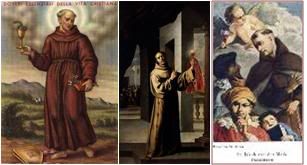 Middle photo: Portrait by Francisco Zurbaran.
ST. GIACOMO DELLA MARCA [James of the Marche] (Italy, 1394-1476)
Middle photo: Portrait by Francisco Zurbaran.
ST. GIACOMO DELLA MARCA [James of the Marche] (Italy, 1394-1476)
Franciscan and Preacher
Born to a poor family in Ancona in the northeast central Italian region called
the Marche, he obtained doctorates in civil and canon law from the University
of Perugia and studied with Saints Bernardine of Siena and John of Capistrano.
Along with Albert of Santeano, the four came to be known as the 'four pillars
of the Franciscan observant movement'. Giacomo was a gifted preacher who
carried the Word all over Italy and to 13 countries in eastern and central
Europe. He had a special devotion to the Holy Name of Jesus, and lived such
a severely austere life that Bernardine advised him to moderate his penances.
He is also remembered for starting the Catholic monte pietatis - non-profit
pawnshops to help the poor. He was canonized in 1726.
OR today.
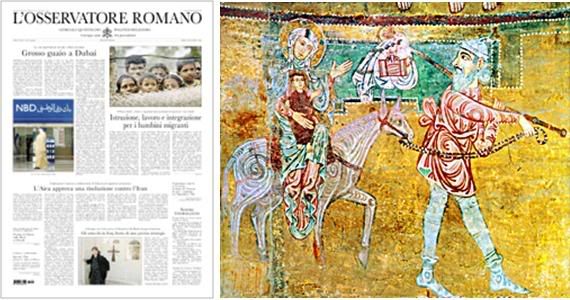 Illustration: The Flight to Egypt (the Holy Family as Refugees)
Illustration: The Flight to Egypt (the Holy Family as Refugees)
In his message for the January 2010 World Day for Migrants and Refugees,
the Pope calls on states and international organisms to respect the rights of children:
'Education, work and integration for under-age migrants'
Other Page 1 stories: A shortfall of $59 billion euros by the state-owned Dubai World Holdings caused world
stock markets to plunge, in the first sign that the Gulf nations are being affected by the world economic
crisis; the IAEA approves a resolution against Iraq for its irregular nuclear development activities; and
an interview with the Archbishop of Mosul of the Syrians on renewed anti-Christian violence in Iraq.
THE POPE'S DAY
The Holy Father met today with
- H.E. Madame Cristina Fernández de Kirchner, President of the Republic of Argentina
- H.E. Madame Michelle Bachelet, President of the Republic of Chile
- Delegations from Argentina and Chile
on the occasion of the XXV anniversary of the Treaty of Peace and Friendship between the two nations,
in which the Vatican played a mediating role. The Pope delivered an address in Spanish.
- Mons. Airton José dos Santos, Bishop of Mogi das Cruzes (Brazil), on ad limina visit, with
Emeritus Archbishop Paulo Antonino Mascarenhas Roxo, O.P.
ADVENT IS HERE

Today at 5:00 PM
St. Peter's Basilica
The Holy Father presides at the First Vespers
of the First Sunday in Advent.

[Modificato da TERESA BENEDETTA 28/11/2009 17:39] |
| |
|
| |
 28/11/2009 17:37 28/11/2009 17:37 |
|
| | | OFFLINE | | Post: 18.960
Post: 1.607 | Registrato il: 28/08/2005
Registrato il: 20/01/2009 | Administratore | Utente Veteran | |
|
 An unprecedented situation at the Vatican today - and one that is not likely to happen again, at least not in the foreseeable future - when two South American Presidents, both women, came to visit the Pope on a very special anniversary.
An unprecedented situation at the Vatican today - and one that is not likely to happen again, at least not in the foreseeable future - when two South American Presidents, both women, came to visit the Pope on a very special anniversary.
 Pope receives Lat-Am Presidents
Pope receives Lat-Am Presidents
on the 25th anniversary of
the Argentina-Chile peace treaty
Translated from
 With President Fernandez of Argentina
With President Fernandez of Argentina
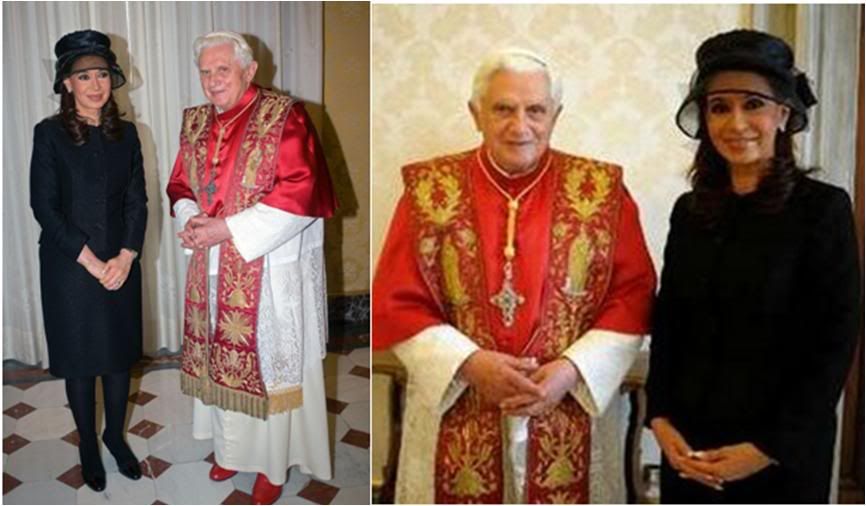
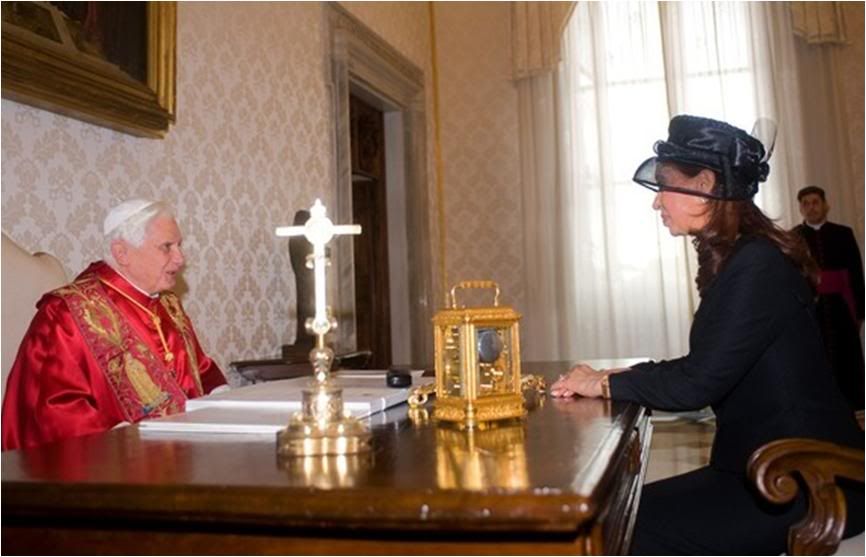 With President Bachelet of Chile
With President Bachelet of Chile
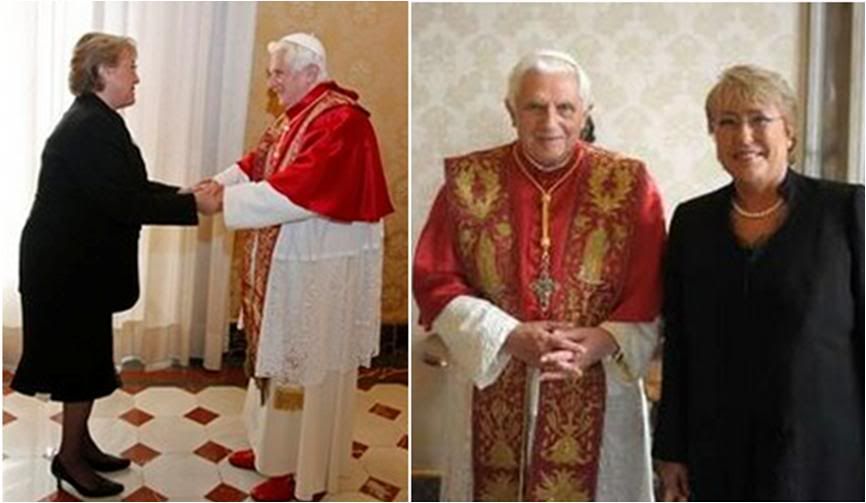
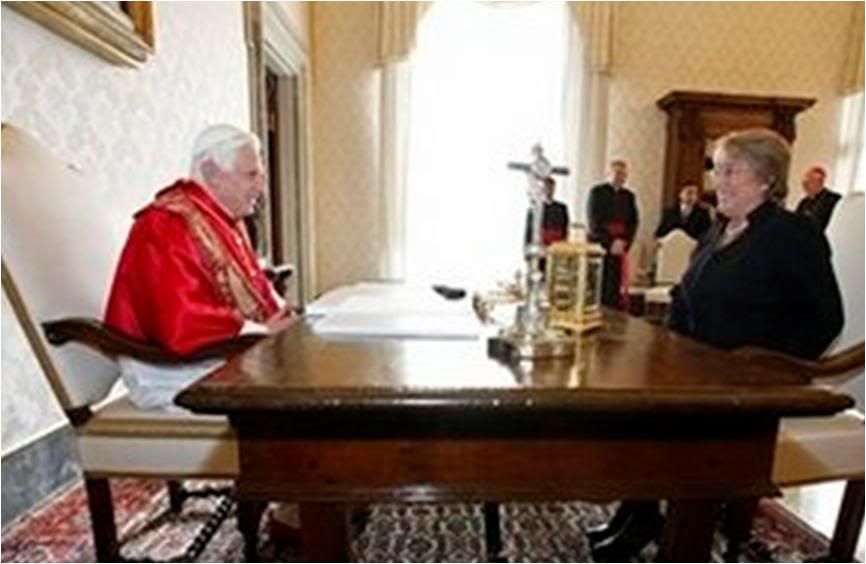
This morning, at the Apostolic Palace, on the occasion of the 25th anniversary of the signing of the Treaty of peace and Friendship between Chile and Argentina, the Holy Father Benedict XVI received in separate audiences the President of Argentina, H.E. Madame Cristina Fernández de Kirchner, and the president of teh Republic of Chile, H.E. Madame Michelle Bachelet Jeria.
The distinguished guests also met afterwards with Cardinal Tarcisio Bertone, Secretary of State, accompanied by Mons. Dominique Mamberti, Secretary for Relations with States.
Afterwards, the Holy Father addressed the two Presidents and their delegations at the Sala Clementina.
During the conversations, the work of mediation carried out by the Servant of God Pope John Paul II and the late Cardinal Antonio Samore - who helped the two nations to settle a long-standing territorial controversy through dialog - was remembered with gratitude.
In particular, they dwelt on the fact that during the past quarter century, the agreement has brought concrete results in prosperity to the two fraternal populations, and continues to be an example and a model for the nations of Latin America and the entire international community.
The present international situation was also discussed.
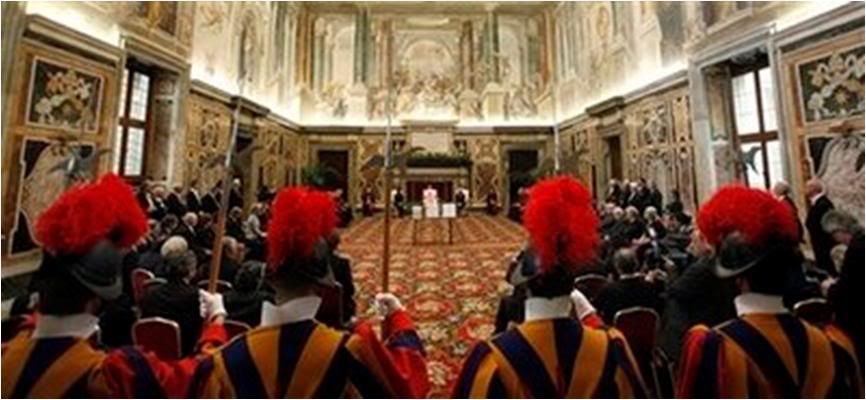
 Pope lauds 1984 peace agreement
Pope lauds 1984 peace agreement
between Argentina and Chile

VATICAN CITY, Nov. 28 (AP) – Pope Benedict XVI hailed a 1984 Vatican-mediated friendship agreement between Argentina and Chile as a "luminous example" of peace winning out over war during an audience Saturday with the presidents of both countries.
In 1978, when both nations were ruled by military dictators, Chile and Argentina nearly went to war over three tiny islands in the Beagle Channel off Chile's southern Pacific shores. The dispute was solved by mediation by Pope John Paul II in 1984.
Benedict marked the 25th anniversary of the treaty during a Vatican audience Saturday with Presidents Cristina Fernandez of Argentina and Michelle Bachelet of Chile.
The Pope met with each President separately, then delivered his speech to their joint delegations in the Vatican's Clementine Hall.
Benedict called the agreement a "luminous example of the strength of the human spirit and the desire for peace over the barbarity and uselessness of violence and war."
Quoting the World War II era pontiff Pope Pius XII he said: "Nothing is lost with peace; everything can be lost with war."
But he said that for peace to be consolidated, there needs to be a fight against poverty and corruption, guaranteed access to education, economic growth and the eradication of violence and exploitation of women and children.
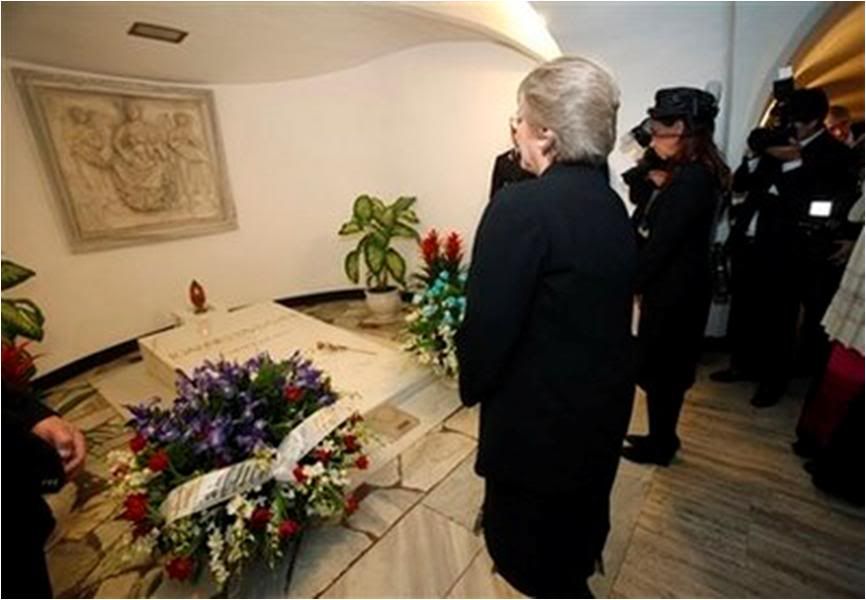
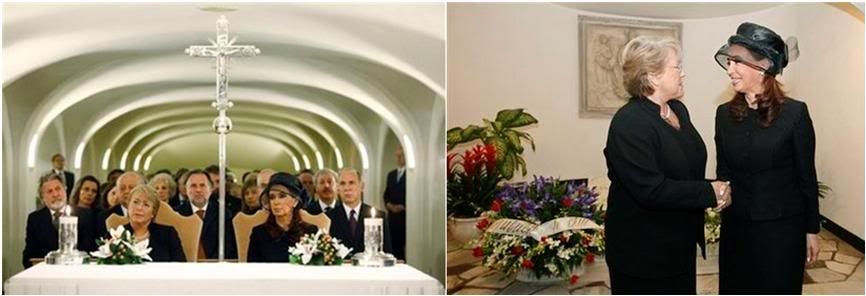
Dressed in black, the two presidents also prayed before John Paul's tomb in the grottos underneath St. Peter's Basilica and visited the Vatican hall where the peace agreements were signed Nov. 29, 1984.
Upon arriving in Rome, the Argentine chancellor Jorge Taiana said the audience would be "a historic round of much joy and renewed alliance as we stop and think about how far we've come in the last 25 years."
John Paul intervened in the dispute in 1979, a year after he was elected Pope, and the treaty signing some five years later marked his first concrete diplomatic achievement.
The Beagle negotiations marked the first papal mediation of a territorial dispute since Pope Leo XXIII stepped into a Spanish-German controversy over the Caroline Islands in the Pacific in 1885.
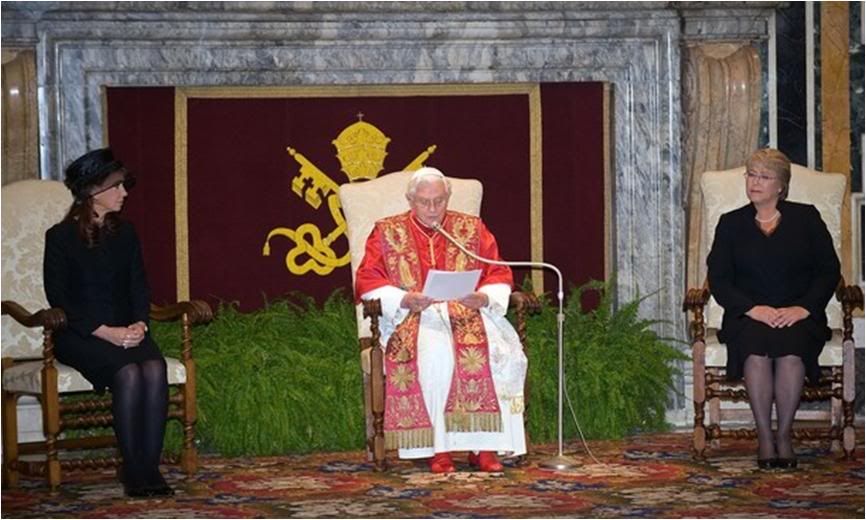 Here is a translation of the Holy Father's address, delivered in Spanish:
Here is a translation of the Holy Father's address, delivered in Spanish:
Mesdames Presidents of Argentina and Chile,
Eminent Cardinals,
Dear brothers in the Episcopate,
Messieurs Ambassadors,
Friends:
1. With great pleasure I welcome you to the See of Peter, on the occasion of the 25th anniversary of the Treaty of Peace and Friendship which settled a long-standing territorial dispute between your countries in the Southern Hemisphere.
Indeed, it is a timely and happy commemoration of those intense negotiations which, with Pontifical mediation, concluded in a worthy, reasonable and equitable solution, thus avoiding armed conflict which would have broken out between two brother nations.
2. The Treaty of Peace and Friendship and the mediation that made it possible, is indissolubly linked to the beloved figure of Pope John Paul II, who, moved by feelings of affection for two beloved nations and in tune with his tireless work as messenger and maker of peace, did not hesitate to accept the delicate and crucial task of being a mediator in a contentious issue.
With the invaluable help of Cardinal Antonio Samore, he himself personally followed all the developments in those lengthy and complex negotiations, until a proposal was defined that led to the signing of the treaty, in the presence of delegations from both nations and Cardinal Agostino Casaroli, who was at the time the Secretary of State to His Holiness as well as Prefect of the Council for the Church's Public Affairs.
The pontifical intervention was also a response to the express petition of the Episcopates of Chile and Argentina, who, in communion with the Holy See, offered their decisive collaboration in order to achieve the said agreement.
We must also thank the efforts of all those who, in the governments and diplomatic delegations of both nations, gave their positive contribution to proceed along the path of peaceful resolution, thus fulfilling the profound desires for peace of the Argentine and Chilean peoples.
3. At a distance of 25 years, we can observe with satisfaction how that historic event has contributed beneficially to reinforce sentiments of fraternity between both nations, along with a more determined cooperation and integration, concretized in numerous economic projects, cultural exchanges, and important works of infrastructure, thus overcoming prejudices, suspicions and reservations held in the past.
Indeed, Chile and Argentina are not just two neighboring countries but so much more: they are two brother nations with a common vocation of fraternity, respect and friendship, in large measure the result of the Catholic tradition which is the basis of their history and rich cultural and spiritual patrimony.
The event we commemorate today is now part of the great history of two noble nations, and also of all Latin America. The Treaty of Peace and Friendship is a luminous example of the power of the human spirit and the desire for peace in the face of barbarism and the irrationality of violence and war as a means to resolve differences.
Once more, one must bear in mind the words that my predecessor, Pope Pius XII, pronounced at a particularly difficult time in history: "Nothing is lost with peace. Everything can be lost with war" (Radio message, August 24, 1939).
That is why it is necessary to persevere at all times with a firm will and until the last consequences in trying to resolve controversies with a genuine desire for dialog and agreement, through patient negotiations and necessary compromises, and always taking into account the just demands and legitimate interests of all concerned.
4. In order that the cause of peace takes root in the mind and heart of all men, and especially, of those who are called on to serve their citizens, starting with the highest magistrates of the land, this must be based on firm moral convictions, on calm spirits, which are sometimes tense and polarized, and on the constant search for the common good at the national, regional and global levels.
Achievement of peace requires the promotion of an authentic culture of life, which fully respects the dignity of the human being, along with strengthening the family as the basic cell of society.
It also demands fighting poverty and corruption, access to quality education for all, economic growth in fraternal solidarity, the consolidation of democracy, and the eradication of violence and exploitation, especially against women and children.
5. The Catholic Church, which continues on earth the mission of Christ, whose death on the Cross brought peace to the world (cf. Eph 2,14-17), will not cease to proclaim to everyone his message of salvation and reconciliation, and, uniting its efforts with those of all men of good will, commits herself eagerly to achieve the aspirations of all men for peace and concord.
Most excellent Mesdames Presidents, dear friends, in thanking you once more for your significant visit, I direct my gaze towards Christ of the Andes, on a peak of that mountain range, and ask him that, as a constant gift of his grace, he may seal for always the peace and friendship between Argentines and Chileans, while, as a token of my affection, I impart on you a special Apostolic Blessing.
IMG]http://i601.photobucket.com/albums/tt96/MARITER_7/2009-2/091128-PRESIDENTS-VATICAN-4A.jpg[/IMG]
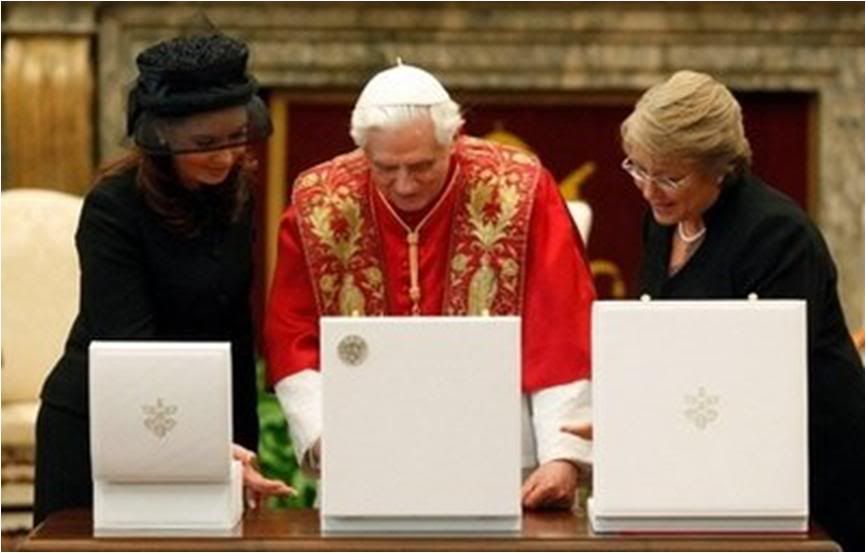
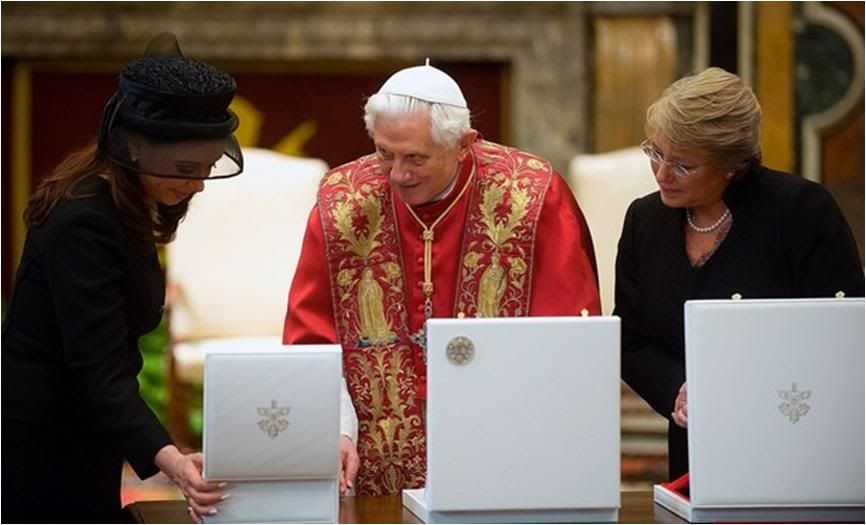
[Modificato da TERESA BENEDETTA 29/11/2009 00:40] |
| |
 28/11/2009 18:18 28/11/2009 18:18 |
|
| | | OFFLINE | | Post: 18.961
Post: 1.608 | Registrato il: 28/08/2005
Registrato il: 20/01/2009 | Administratore | Utente Veteran | |
|
 FIRST VESPERS
FIRST VESPERS
TO MARK THE START OF ADVENT
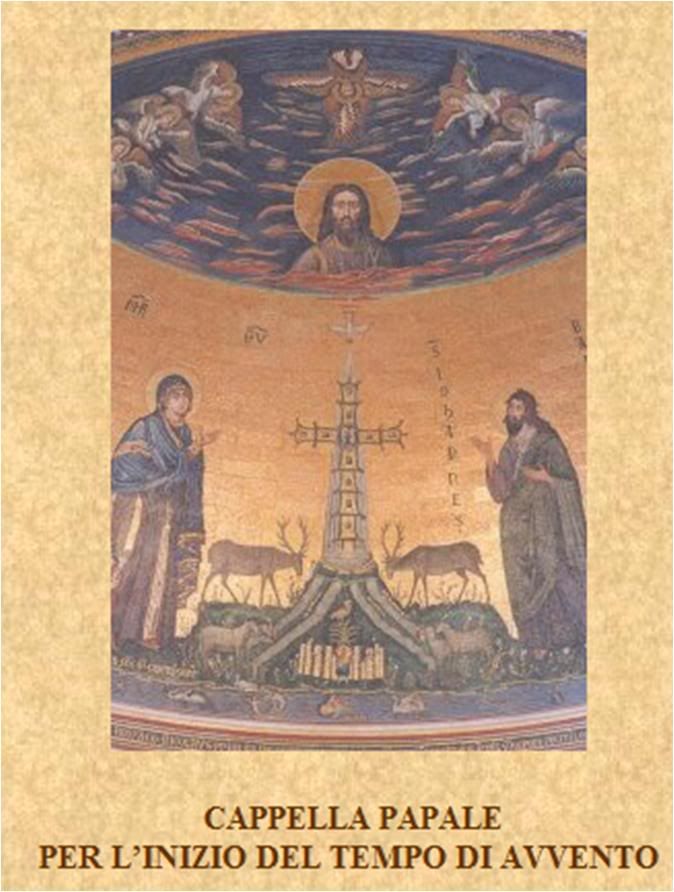 NB: The illustration is the cover for the libretto today,
NB: The illustration is the cover for the libretto today,
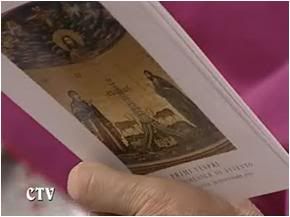
but the text itself was not posted online,
as it is the same liturgical text from last year's First Vespers, and can be found on
www.vatican.va/news_services/liturgy/libretti/2008/vespri_2008...

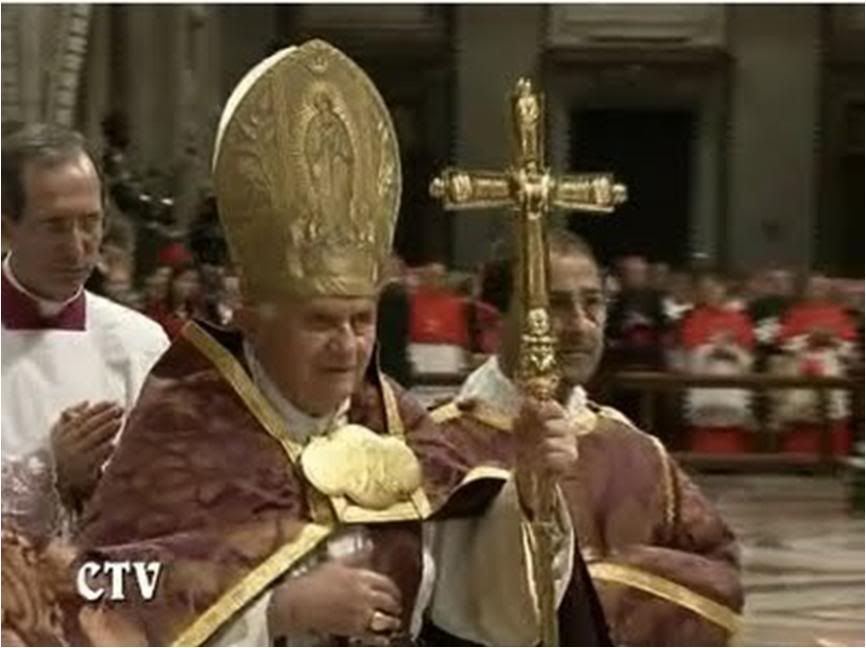
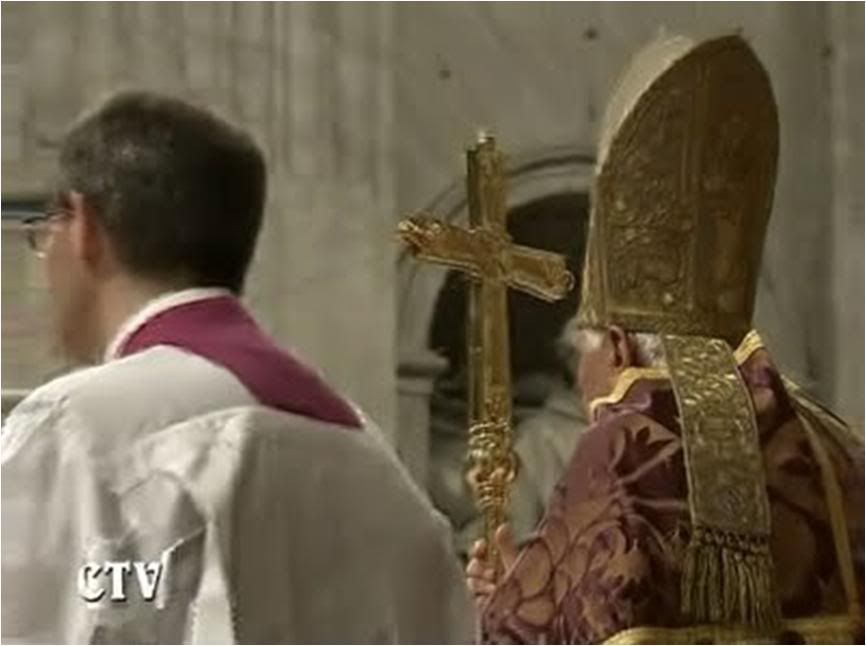
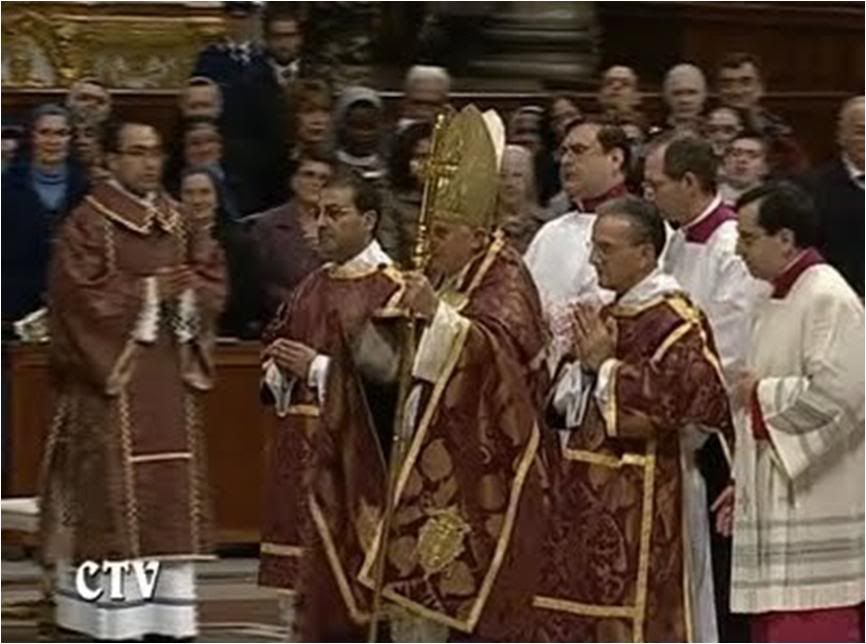
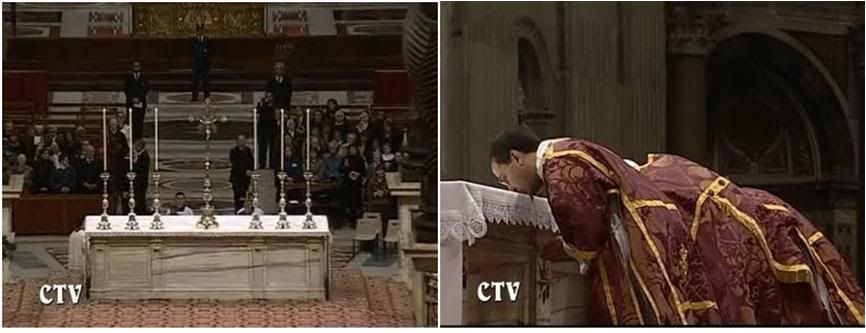

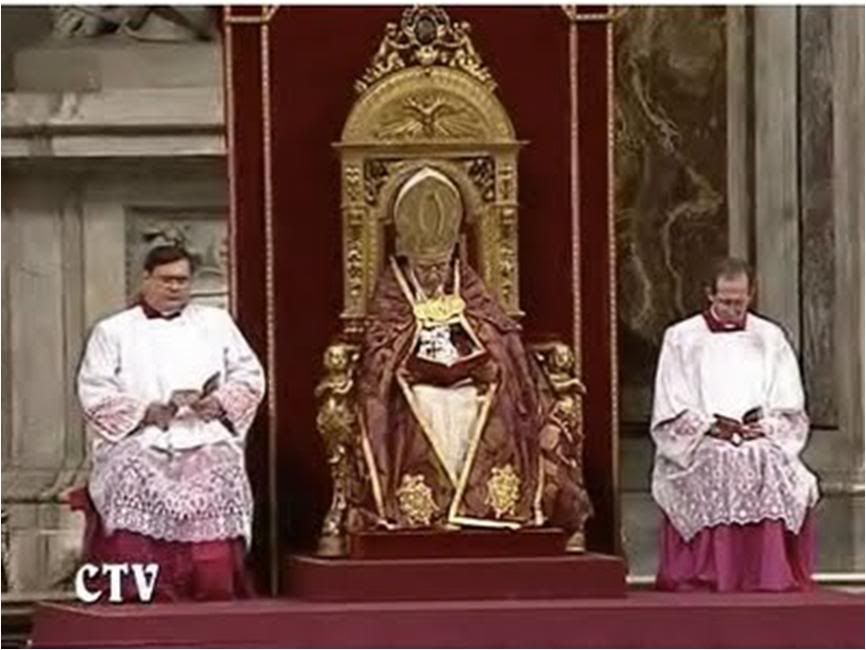
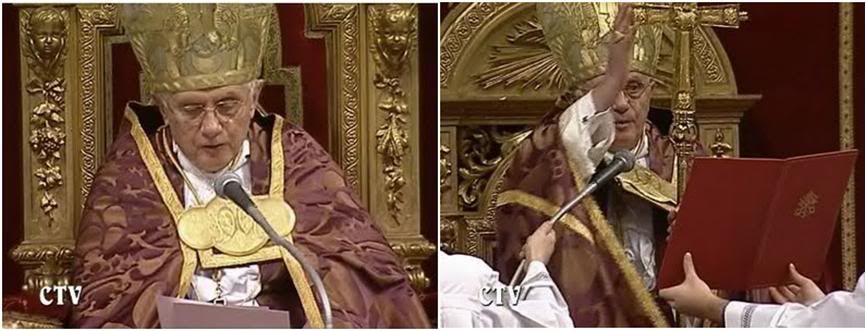
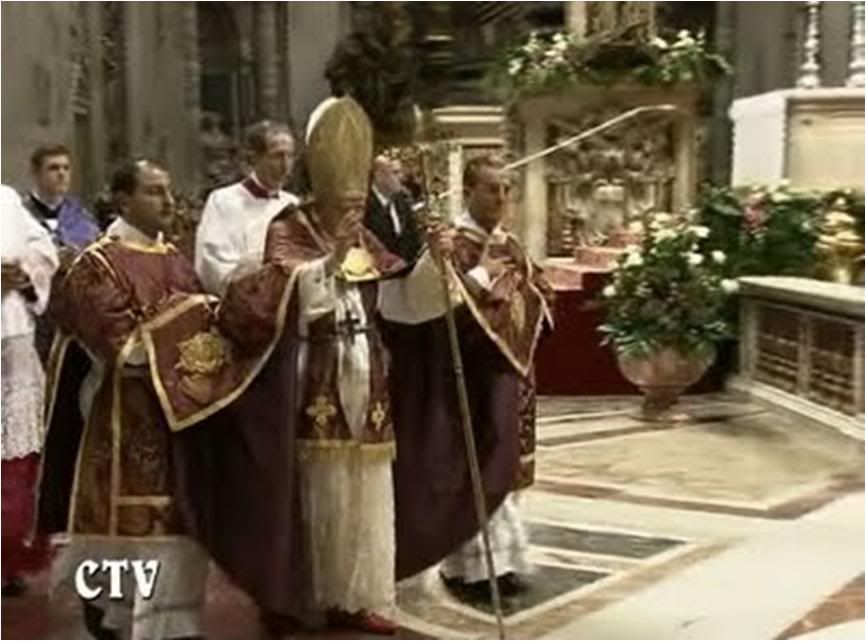 Thanks to
Thanks to

for the above videocaps...
and the first photos of Papino with his brand-new personal staff.
Here is a translation of the Holy Father's homily:
Dear brothers and sisters:
With this Vespers celebration, we enter the liturgical season of Advent. In the Biblical reading that we just heard, taken from the first Letter to the Thessalonians, the Apostle Paul invites us to prepare for "the coming of the Lord, our Jesus Christ" (5,23), who preserves us blameless, with the grace of God.
Paul uses the word 'coming' - in Latin, adventus, whence the term Advent. Let us reflect briefly on the meaning of this word, which can be translated as 'presence', 'arrival', 'coming'.
In the language of the ancient world, it was a technical term used to indicate the arrival of a functionary, the visit of the king or emperor to a province. But it could also mean the arrival of divinity, who emerges from hiding to manifest itself with power, or whose presence is celebrated in worship.
Christians adopted the word Advent to express their relationship with Jesus Christ: Christ is the King, who has entered this poor 'province' called earth to make a visit to everyone. In the feast of His coming, all participate who believe in Him, all who believe in His presence in the liturgical assembly.
The word adventus was substantially intended to say: God is here, he has not retired from the world, he has not left us alone. Even if we cannot see and touch Him as we can with sensible realities, He is here and comes to visit us in multiple ways.
The significance of the word Advent thus also comprehends that of visitatio, which means a visit pure and simple. In this case, it is a visit by God: He enters my life and addresses himself to me. Yet we all experience in daily life that we have little time for the Lord, and little time even for ourselves. We end up being absorbed by 'doing'.
Is it not perhaps true that often it is this activity that possesses us, that it is society with its multiple interests that monopolizes our attention? Is it not perhaps true that we devote too much time to diversions and amusements of various kinds? Sometimes, things 'overwhelm' us.
Advent, this important liturgical time that we are beginning, invites us to pause in silence to understand a presence. It is an invitation to understand that the single events of the day are signs that God addresses to us, signs of the attention that he has for each of us.
How often God makes us perceive something of his love! To keep an interior diary, so to speak, of this love would be a beautiful and healthy task in our life.
Advent invites and stimulates us to contemplate the Lord who is present. Should not the certainty of his presence help us to see the world with different eyes? Should it not help us to consider all of our existence as a 'visit', as a way in which He can come to us and be near to us in every situation?
Another fundamental element of Advent is waiting - which is at the same time, hope. Advent impels us to understand the sense of time and history as kairos, as a favorable occasion for our salvation.
Jesus has illustrated this mysterious reality in many parables: in the story of the servants asked to await the return of the master; in the parable of the virgins awaiting the spouse; or in that about sowing and harvesting.
In life, man is in a constant state of waiting: As a child, he wants to grow; as an adult, he aims for realization and success; as he advances in age, he aspires for a deserved rest. But the time comes when he discovers that he has hoped too little, if beyond professional or social position, he has nothing more to hope for.
Hope marks the path of humanity, but for Christians, it is inspired by a certainty: The Lord is present in the course of our life, he accompanies us and one day he will dry our tears. One day, not far, everything will find its fulfillment in the Kingdom of God, a kingdom of justice and peace.
But there are different ways of waiting.
If the time is not filled with a present that has sense, waiting risks becoming insupportable. If one expects something, but for now, there is nothing - that is, if the present remains empty - then every moment that passes appears exaggeratedly long, and waiting is transformed into a very grave weight, since the future remains completely uncertain.
But when time is endowed with sense, and in every instant. we perceive something specific and valid, then the joy of waiting makes the present more precious.
Dear brothers and sisters, let is live the present intensely, in which already the gifts of the Lord are at hand. Let us live the present projected towards the future, a future full of hope.
Christian Advent becomes in this way an occasion to re-establish in us the true sense of waiting, returning to the heart of our faith which is the mystery of Christ. The Messiah who had been awaited for many centuries was born in poverty in Bethlehem.
In coming into our midst, he brought us and continues to offer us the gift of his love and his salvation. Present among us, he speaks to us in many ways: in Sacred Scripture, in the liturgical year, in the saints, in the events of daily life, in all of Creation which changes its aspect depending on whether Christ is behind it all or is obscured by a fog of uncertain origin and uncertain future.
In turn, we can address ourselves to him, present him with the sufferings that afflict us, the impatience, the questions which gush forth from our heart. We can be sure that he always listens to us!
And if Jesus is present, there is no time that is empty or devoid of sense. If He is present, we can continue to hope even if others can no longer assure of us of any support, even when the present becomes arduous.
Dear friends, Advent is the time of the presence of the eternal as we wait for it. For this very reason, it is in a special way a time of joy, of an internalized joy that no suffering can annul - it is joy at the fact that God made himself a Baby.
This joy, invisibly present in us, encourages us to walk on confidently. The model and support for such intimate joy is the Virgin Mary, through whom the Baby Jesus was given to us.
May she, faithful disciple of her Son, obtain for us the grace to live this liturgical time vigilant and industrious in our waiting. Amen!
Now, the news agency photos so far - they show the 'real colors' but also tell only part of the story:
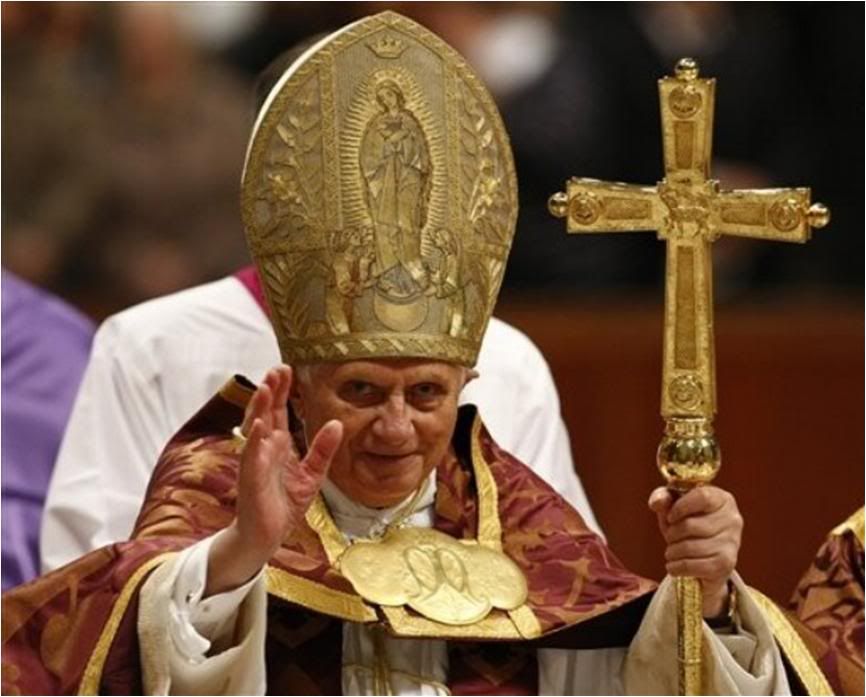
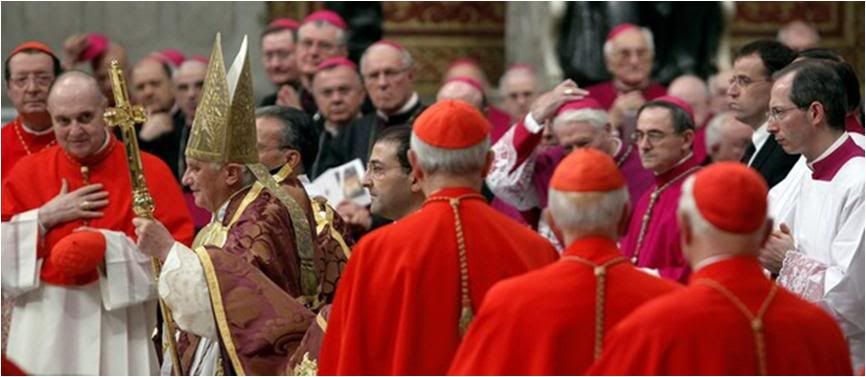
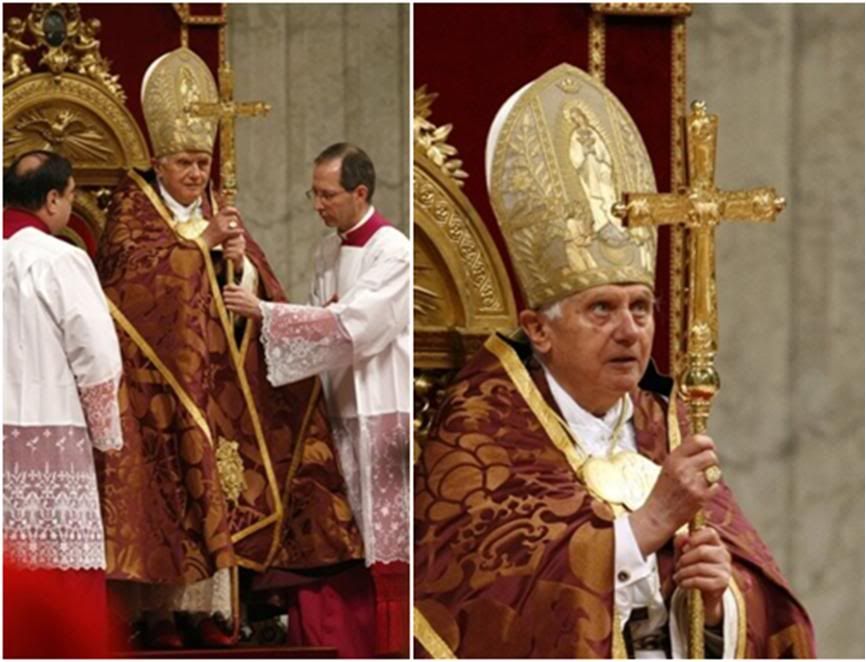
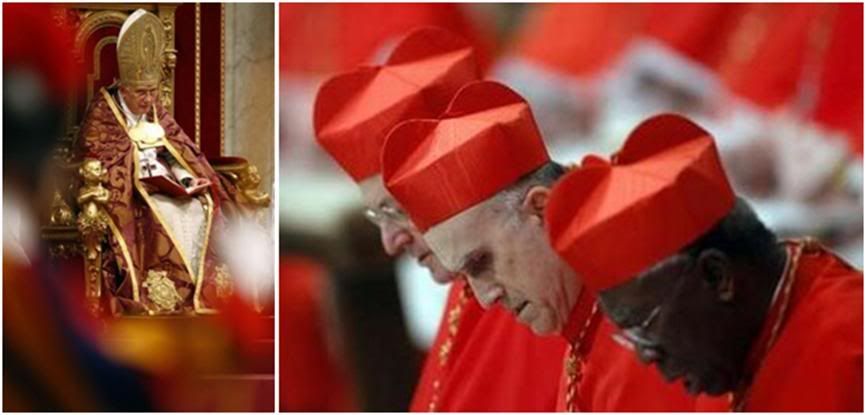
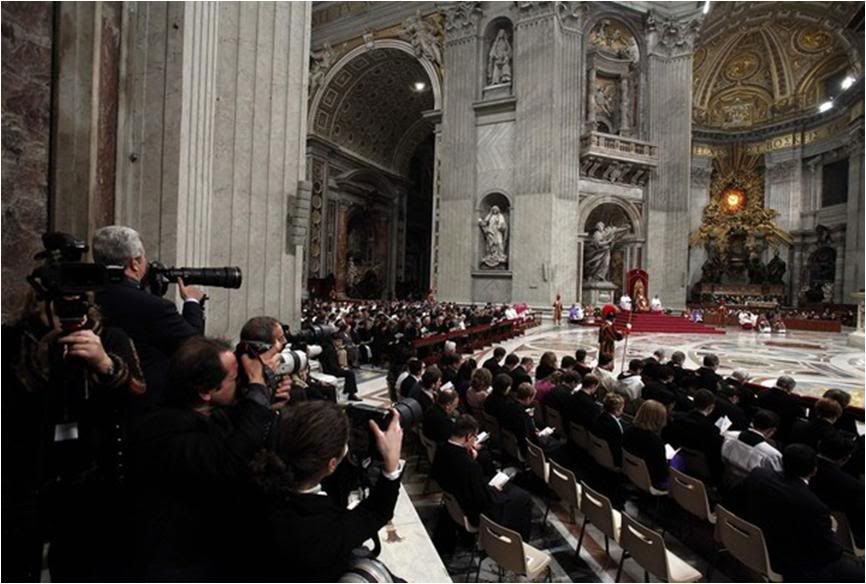
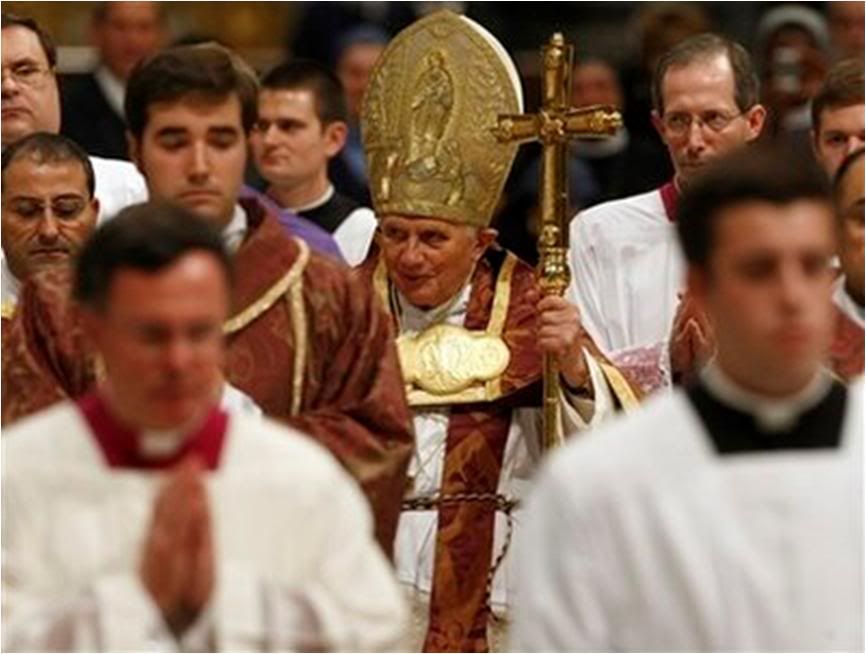
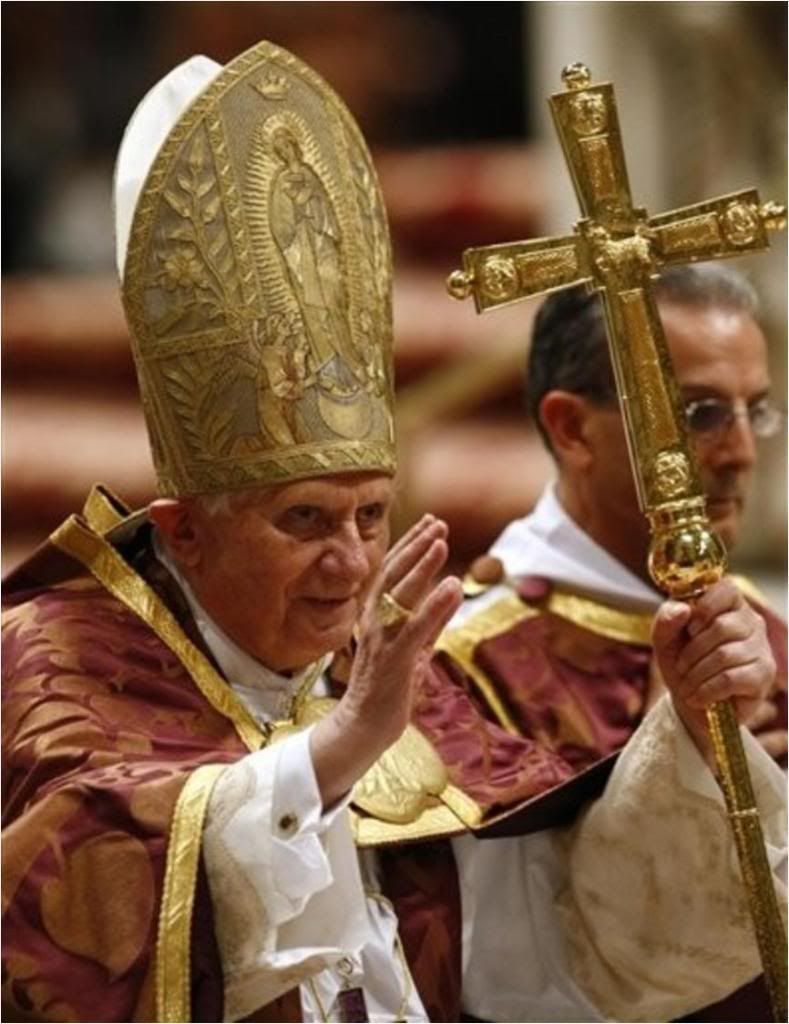 Watched the ceremony on EWTN but could not get it online, not even thru Vatican Radio, so no videocaps of my own.
Watched the ceremony on EWTN but could not get it online, not even thru Vatican Radio, so no videocaps of my own.
The ceremony was one of the most beautiful Vespers I have watched recently. The 'standard' sacred music for Vespers was very evocative and moving, and the new silences observed after each psalm (as well as after the readings and homily), added greatly to the solemnity.
[See OR article in preceding page in which Mons. Guido Marini explains all about the new pastoral staff, the innovations in the Vespers celebration, and why purple is the color of Advent.]
The Holy Father's new personalized pastoral staff looks beautiful. The figures in relief are easily appreciable and its golden-bronze tone is very warm, but I think the front and back cross faces should have been joined together at the sides, and not left with an 'open' sideview, as it looks unfinished that way (which also gives the sacristan much more to clean and polish with cramped space to do it in.
 But note how the knob below the Cross reflects the scene inside the Basilica so clearly.
But note how the knob below the Cross reflects the scene inside the Basilica so clearly.
Also, the Holy Father may have returned Pius IX's ferula back to the Sacristy Treasury, but today he used a Pius IX miter, which has the Immaculate Conception in front, and I believe, the Good Shepherd behind.
The three staffs:
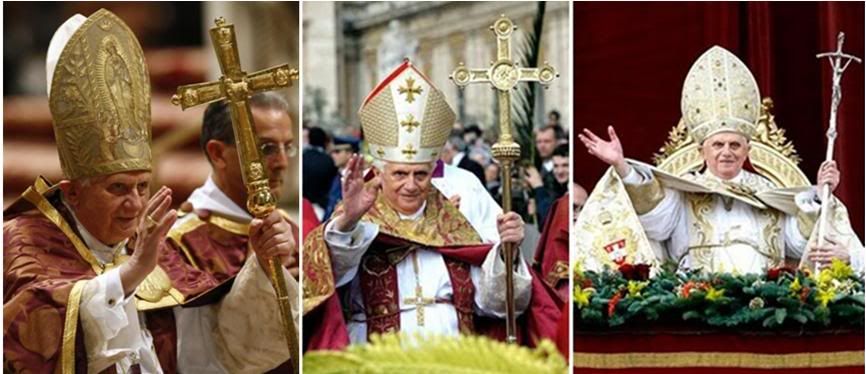
[Modificato da TERESA BENEDETTA 29/11/2009 01:26] |
| |
 29/11/2009 03:08 29/11/2009 03:08 |
|
| | | OFFLINE | | Post: 18.963
Post: 1.610 | Registrato il: 28/08/2005
Registrato il: 20/01/2009 | Administratore | Utente Veteran | |
|
 ADDENDUM: FIRST VESPERS
ADDENDUM: FIRST VESPERS
AT THE START OF ADVENT
Thanks to Caterina for her montage of the Vespers. Among other things, she captures an image of the polychrome Madonna that has been introduced into the Advent rites in St. Peter's.
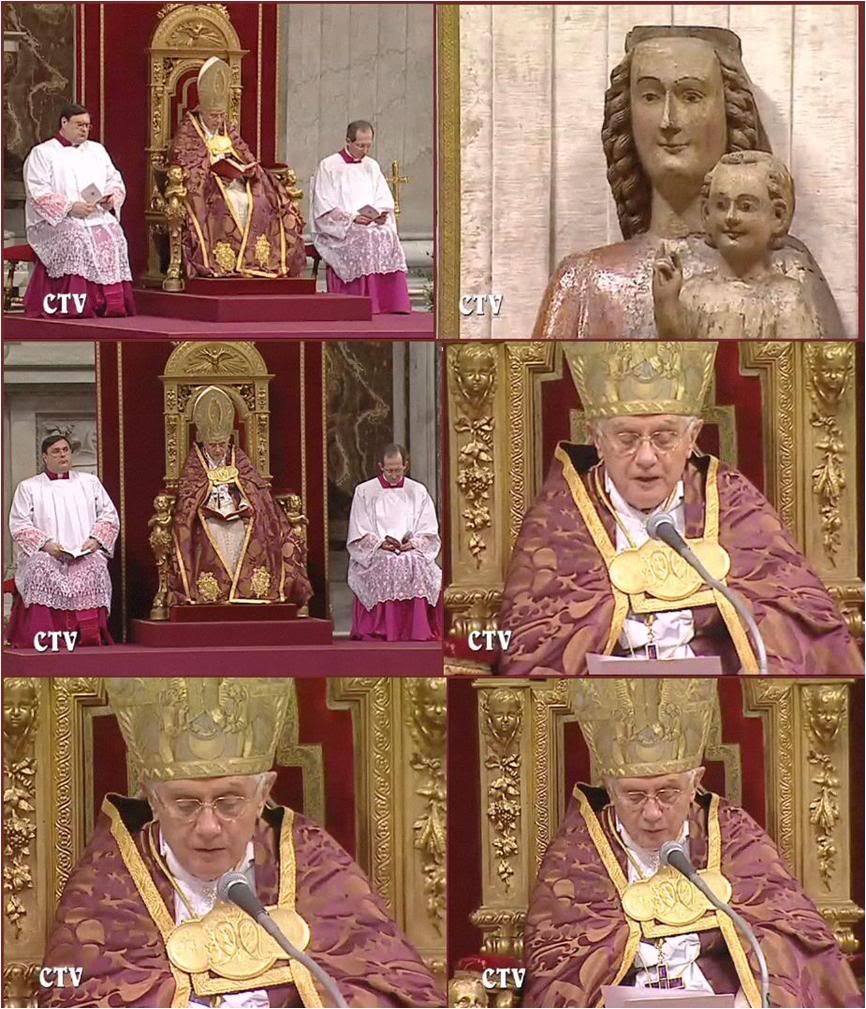
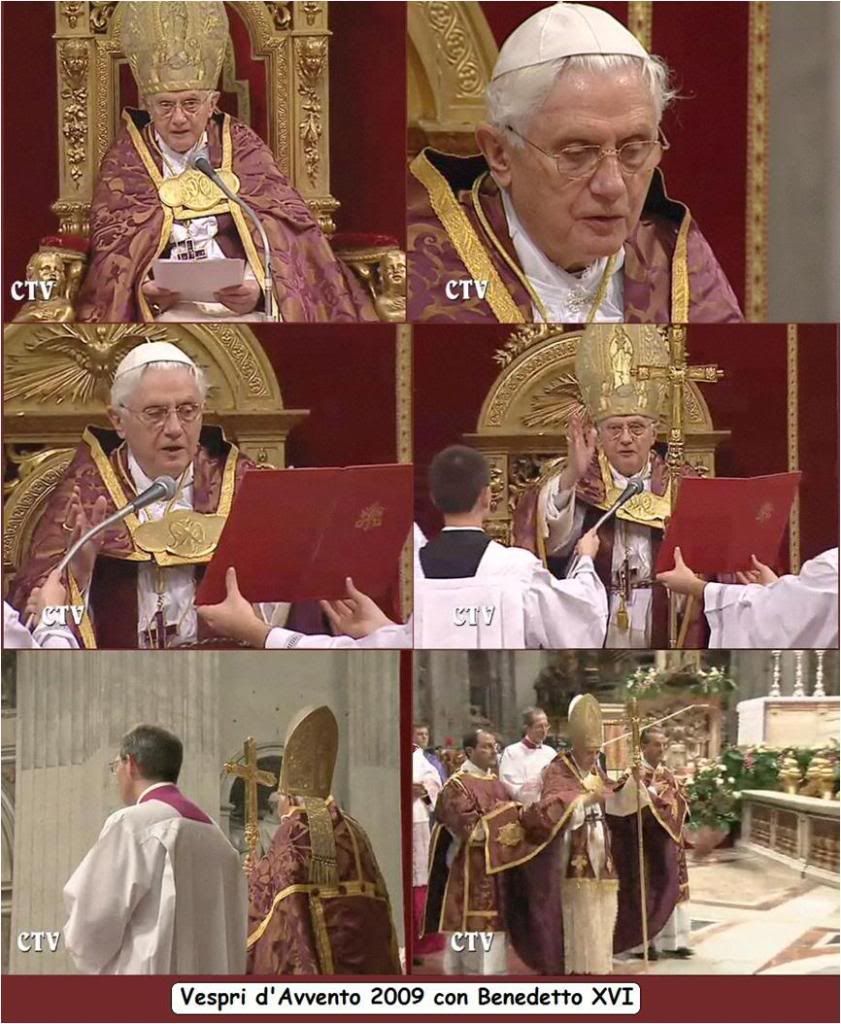
|
| |
 29/11/2009 15:06 29/11/2009 15:06 |
|
| | | OFFLINE | | Post: 18.964
Post: 1.611 | Registrato il: 28/08/2005
Registrato il: 20/01/2009 | Administratore | Utente Veteran | |
|

 Sunday, November 29
Sunday, November 29
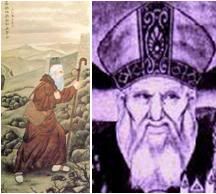 Servant of God GIOVANNI DA MONTECORVINO (b Italy 1247, d Beijing 1328)
Servant of God GIOVANNI DA MONTECORVINO (b Italy 1247, d Beijing 1328)
Franciscan, Missionary, Papal Legate to Persia, India and Kublai Khan
A contemporary of Marco Polo, this gifted Franciscan has an amazing biography
it is surprising his cause for beatification has only come up fairly recently. After
establishing missions in Persia and India en route to China, he set up the first
Catholic mission in that country. Based in what would become Beijing, he was
named the first Archbishop of that city. When he died, his tomb quickly became
a place for pilgrimage but 40 years later, Christianity was banished from China
after the Mings expelled the Mongol dynasty.
OR today.
 Illustration: The Annunciation, 12th century icon.
Illustration: The Annunciation, 12th century icon.
On the 25th anniversary of Argentina-Chile peace treaty, the Pope reiterates
that peace is founded on solid moral convictions:
'Violence and war are not the way to resolve controversies'
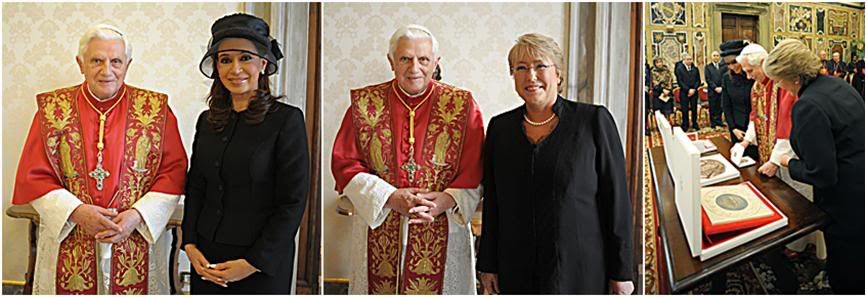 Today's issue gives extensive play to the visit yesterday of the Presidents of Argentina (left photo) and Chile (center), with three other articles in the inside pages. The start of Advent is marked by an essay on the Annunciation in the Syro-Catholic tradition, 'You have made of earth a second heaven'. Other Page 1 stories: Iran says IAEA resolution against it is a useless document; and the US and Russia may fail to reach a new agreement on reducing their nuclear arms stockpile before the current agreement expires Dec. 5.
THE POPE'S DAY
Sunday Angelus
Today's issue gives extensive play to the visit yesterday of the Presidents of Argentina (left photo) and Chile (center), with three other articles in the inside pages. The start of Advent is marked by an essay on the Annunciation in the Syro-Catholic tradition, 'You have made of earth a second heaven'. Other Page 1 stories: Iran says IAEA resolution against it is a useless document; and the US and Russia may fail to reach a new agreement on reducing their nuclear arms stockpile before the current agreement expires Dec. 5.
THE POPE'S DAY
Sunday Angelus - The Holy Father spoke of Advent and the liturgical year, and the hope every man has
because Christ came to earth and is with us to the end of time. He also asked for prayers and concrete
assistance for all those who are afflicted with AIDS as the world observes a day for them on Dec. 1.
[Modificato da TERESA BENEDETTA 30/11/2009 17:05] |
| |
 29/11/2009 15:33 29/11/2009 15:33 |
|
| | | OFFLINE | | Post: 18.965
Post: 1.611 | Registrato il: 28/08/2005
Registrato il: 20/01/2009 | Administratore | Utente Veteran | |
|
 ANGELUS TODAY
ANGELUS TODAY
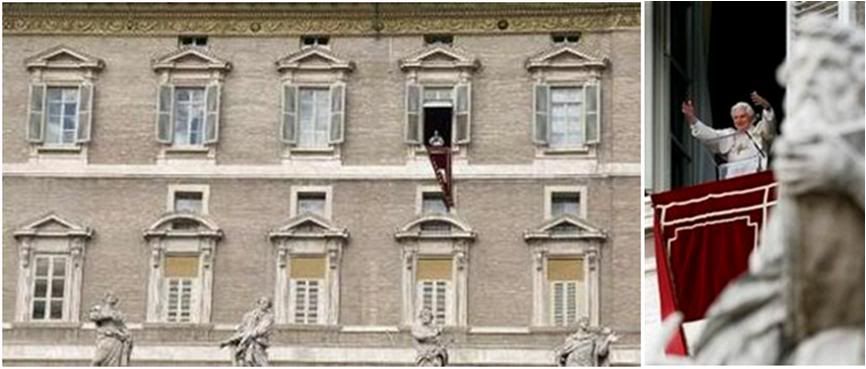
The Holy Father today spoke of Advent and the liturgical year, and the hope every man has because Christ came to earth and is with us to the end of time.
He also asked for prayers and concrete assistance for all those who are afflicted with AIDS in connection with the World Day against AIDS on Dec. 1.
Here is what he said to English-speaking pilgrims:
I welcome all the English-speaking pilgrims and visitors present for the Angelus. On this First Sunday of Advent let us join with Mary in prayerful trust, watchful for the presence of Jesus in our world, mindful of our need to grow in compassion and mercy, and ready to embrace God’s will as a sign of hope. Upon you and your families I invoke God’s abundant blessings of joy and peace.
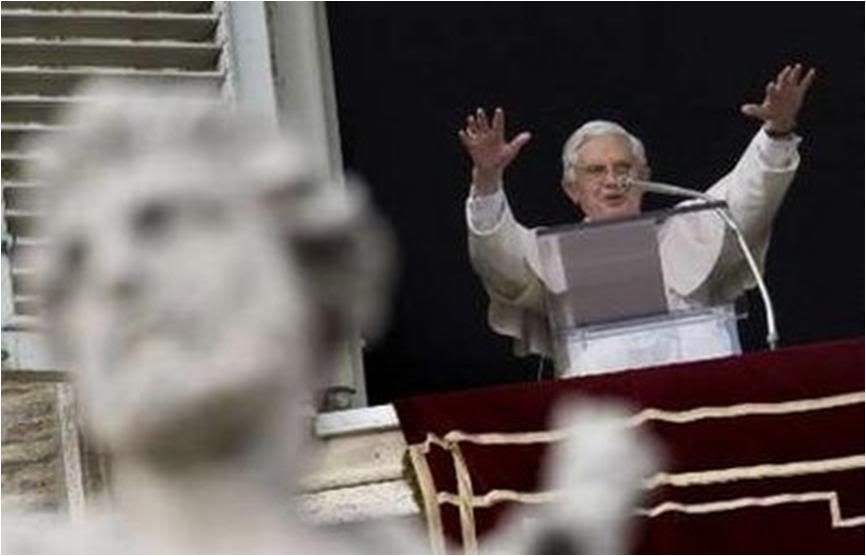
 Here is a translation of the Holy Father's words today:
Here is a translation of the Holy Father's words today:
Dear brothers and sisters!
This Sunday, by the grace of God, we start a new liturgical year which opens naturally with Advent, a time of preparation for the Nativity of the Lord.
The Second Vatican Council, in its Constitution on liturgy, affirmed that the Church "in the annual cycle presents the entire mystery of Christ, from the incarnation and birth until the ascension, the day of Pentecost, and the expectation of blessed hope and of the coming of the Lord"
In this way, "recalling the mysteries of redemption, the Church opens to the faithful the riches of her Lord's powers and merits, so that these are in some way made present for all time, and the faithful are enabled to lay hold upon them and become filled with saving grace" (Sacrosanctum concilium, 102).
The Council insists on the fact that the center of the liturgy is Christ, as the sun around which revolve, like planets, the Blessed Virgin Mary and the martyrs and saints who "sing God's perfect praise in heaven and offer prayers for us" (ivi, 104).
This is the reality of the liturgical year, seen, so to speak, 'from God's side'. What about on the part of man, of history and of society? What relevance can it have?
The answer is suggested to us precisely by the journey of Advent, which we undertake today.
The contemporary world needs hope above all: it is needed by peoples in development, but even by those who are economically evolved. More and more we find that we are all on the same boat and we should all save ourselves together.
Above all, we have become aware, as we see so many false securities collapsing, that we need a hope we can trust in, and this is found only in Christ, who, as the Letter to the Hebrews says, "is the same yesterday and today and for always" (13.8).
The Lord Jesus came in the past, he comes in the present, and he will come in the future. He embraces all the dimensions of time, because he died and rose again - he is 'the Living One' and, while he shared our human precariousness, he remains for always and offers us the stability of God himself.
He is 'flesh' like us and 'rock' like God. Whoever yearns for freedom, for justice, for peace, can stand and hold his head up, because in Christ, freedom is at hand (cfr Lk 21,29) - as we read in today's Gospel.
Thus, we can affirm that Jesus Christ does not concern Christians alone, or believers alone, but all men, because He, who is the center of our faith, is also the foundation for hope. And every human being is always in need of hope.
Dear brothers and sisters, the Virgin Mary fully incarnates mankind who lives in hope based on faith in the living God. She is the Virgin of Advent: she is firmly planted in the present, in the 'today' of salvation. In her heart, she holds all past promises, and she points to future fulfillment.
Let us place ourselves in her school, in order to truly enter this time of grace and welcome, with joy and responsibility, the coming of God into our personal and social history.
After the prayers, he said this:
December 1 will be the annual World Day against AIDS. My thoughts and prayers go to every person afflicted with this disease, particularly the children, the poor, and those who are rejected.
The Church does not cease to do its best in order to fight AIDS through its institutions and the personnel dedicated to this work.
I call on everyone to give his own contribution in prayer and concrete attention so that all who are infected with the HIV virus may experience the presence of the Lord who gives comfort and hope.
Finally, I hope that by multiplying and coordinating all efforts, we may arrive at stopping and overcoming this disease.
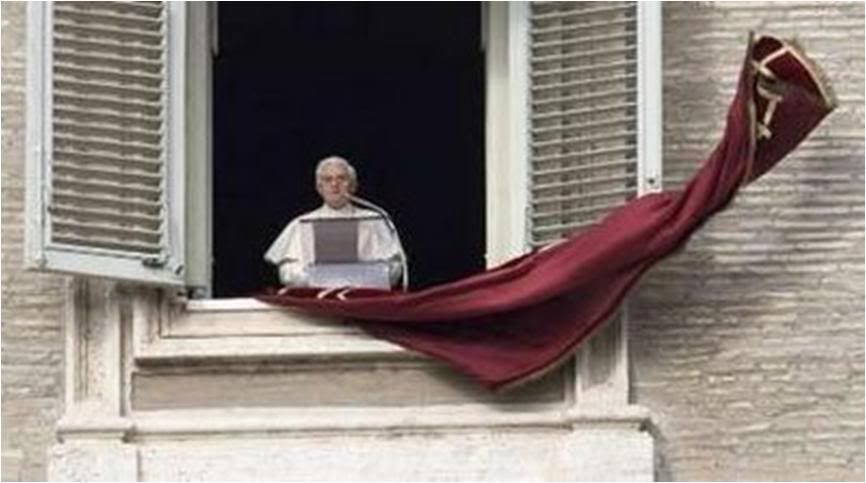

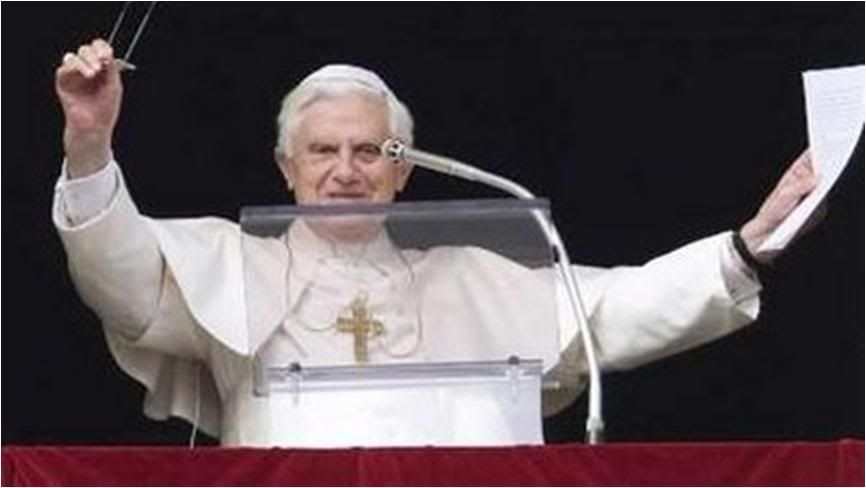 In his Italian greeting, the Holy Father acknowledged the presence of demonstrators in behalf of keeping the Cross in Italian schools and public places:
In his Italian greeting, the Holy Father acknowledged the presence of demonstrators in behalf of keeping the Cross in Italian schools and public places:
I affectionately greet all Italian-speaking pilgrim, particularly those who took part in the march promoted by the Movimente dell'Amore Familiare [Movement for Family Love'] to manifest their profound love for the Crucifix, recognizing its religious, historical and cultural value.
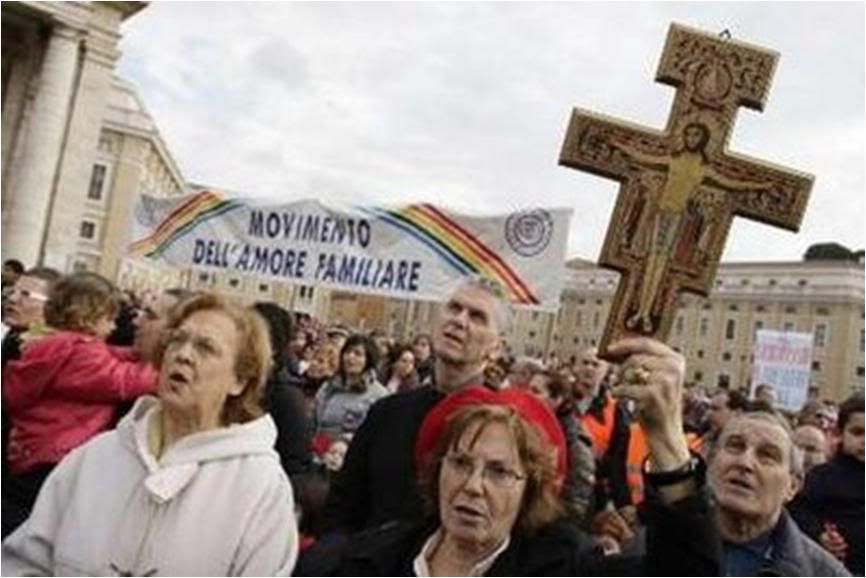
[Modificato da TERESA BENEDETTA 30/11/2009 13:46] |
| |
 29/11/2009 19:36 29/11/2009 19:36 |
|
| | | OFFLINE | | Post: 18.967
Post: 1.614 | Registrato il: 28/08/2005
Registrato il: 20/01/2009 | Administratore | Utente Veteran | |
|
 Pope needs much larger
Pope needs much larger
Mass space in Turin
by ERICA DI BLASI
Translated from

Nov. 28, 2009
Pope Benedict XVI will be celebrating Mass at Turin's Piazza San Carlo when he visits the Piedmont capital on May 2 next year for the Exposition of the Holy Shroud.
Originally the Mass was to be held at the Piazza del Duomo, in front of the Cathedral where the Shroud will be on public exposition, but the cathedral square is 'too small'.
"We made the decision because of the great number of faithful who are expected to come to Turin to see the Pope", said Mons. Giuseppe Ghiberti, vice-president of the Exposition Committee.
"Piazza San Carlo is not only beautiful but it can accommodate at least 50,000 to as many as 60,000," he pointed out. "Though we think the attendance will even be more, people can easily find space on both sides of Via Roma that leads into it".
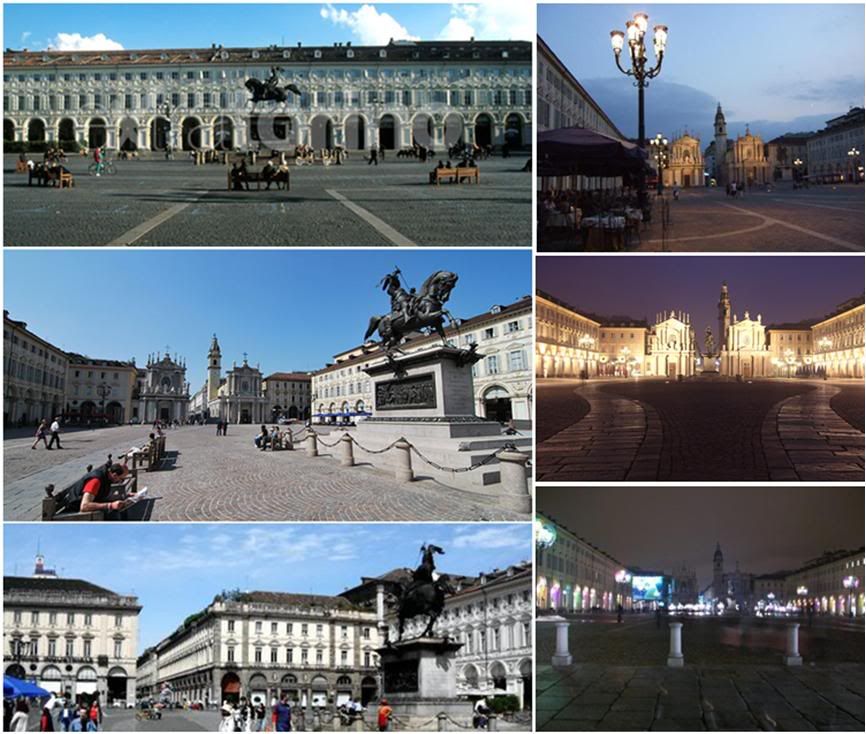 Right panel, top to bottom: Arcades lining the square; and the two ends opening out to Via Roma.
Right panel, top to bottom: Arcades lining the square; and the two ends opening out to Via Roma.
Left panel: Views of the square showing the two 17th-century churches framing one end.
The city commune welcomed the decision. Said Turin's cultural consultant, Fiorenzo Alfieri: "Piazza San Carlo is entirely appropriate, especially now that it is a traffic-free zone. We will set up the stage between the two churches and a maxi-screen behind the equestrian statue"
The city is already humming with preparations for the Exposition from April 23 to May 10, Four thousand volunteers have been recruited so far. The website www.sindone.org has been updated and is now accessible in more languages including Russian.
Web curators said it was in consideration of the millions of faithful, both Catholic and Orthodox, in eastern Europe, especially those who plan to visit the Shroud.
Starting December 1, it will be possible to get a reservation online to visit the Shroud. A telephone call center will be activated on Jan. 1.
In a few days, the regional education office is launching a literary and multimedia contest about the Holy Shroud at the elementary, middle school and collegiate levels. The contest is con-sponsored by the Diocese of Turin and the Committee for the Exposition of the Shroud.
They intend it to become an educational opportunity to help children adn young people "know the figure of Jesus better as well as the essential story of the Shroud".
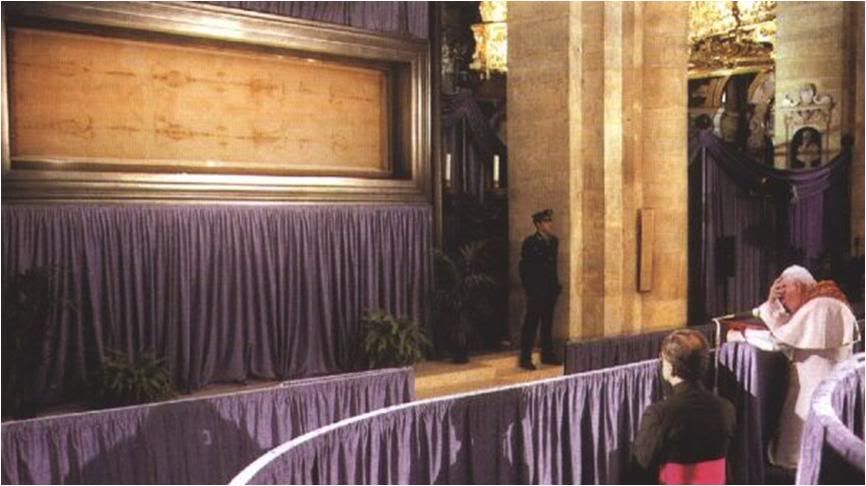 John Paul II venerating the Shroud at its last public exposition in 1998.
John Paul II venerating the Shroud at its last public exposition in 1998.
[Modificato da TERESA BENEDETTA 30/11/2009 17:11] |
| |
 30/11/2009 02:07 30/11/2009 02:07 |
|
| | | OFFLINE | | Post: 18.968
Post: 1.615 | Registrato il: 28/08/2005
Registrato il: 20/01/2009 | Administratore | Utente Veteran | |
|
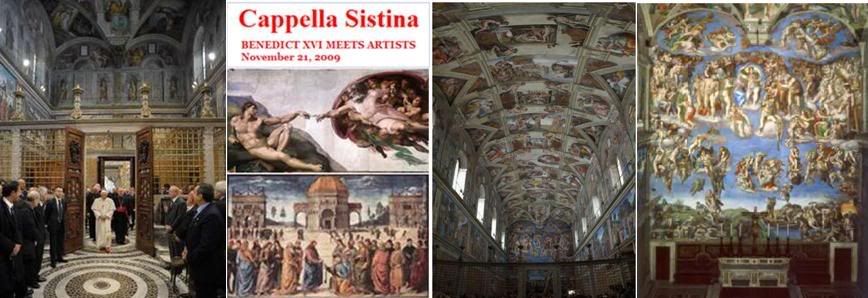 One week after the Pope's meeting with artists, they are still writing about it. Paticularly those who do not want to see it as just a flash in the pan and want an active follow-through. In Avvenire, these two essays were written by two artists who took part - Davide Rondoni, a poet and an editorial writer for Avvenire; and novelist Ferdinando Camon, who stirred up some reaction from fellow artists for what he wrote in La Stampa right after the meeting.
To find around the Pope
One week after the Pope's meeting with artists, they are still writing about it. Paticularly those who do not want to see it as just a flash in the pan and want an active follow-through. In Avvenire, these two essays were written by two artists who took part - Davide Rondoni, a poet and an editorial writer for Avvenire; and novelist Ferdinando Camon, who stirred up some reaction from fellow artists for what he wrote in La Stampa right after the meeting.
To find around the Pope
even those one least expects
by DAVIDE RONDONI
Translated from

Nov. 28, 2009
Many reactions followed the Pope's meeting with us artists in the Sistine Chapel Saturday before last.
The event made a great impression for the very simplicity with which it was carried out and the elementary force of its message.
The Pope, in short, offered the friendship of the Church to contemporary artists in the name of the quest for beauty.
He did not ask for anyone to adhere to an aesthetic program or to any ideology of art or style. And even if some - including some in the Italian media - sought to snob the event entirely, its importance has been affirmed, thanks to the power of the Pope's message and the reception it got from those who had taken part in the meeting and from so many others who read or learned about it.
Thus, many reactions. Beyond the most banal and superficial over who was invited and who was not, who came or did not - an exercise by those who have little they can say about its essence - there have been reactions from those who would have wanted the message limited only to certified Catholics or Christians; from some who, although distant from the faith, felt quite at home; and from others, who were amazed, and rather irritated, that artists who were far from Christian positions, had accepted the invitation.
To all these reactions one would wish to respond, "That is what the Church is - beauty". Because it seems, that in some sense, there are those among them who have just now 'discovered' that the Church is catholic, universal. The bearer of a historical experience that concerns everyone, that is open to everyone and that dialogs with everyone.
The fact that contemporary artists accepted an invitation from Benedict XVI - from the Pope whom many insist on portraying as an obscurantist - annoys only those who do not know this Pope nor the catholic nature of the Church. It is almost funny.
But it shows the degree to which, in the cultural field, a certain intellectual laziness is active, some preconceptions - laziness and preconceptions as are placed in crisis by an event like that at the Sistine Chapel.
The know-alls have always been scandalized that the Church does not think as they do. And the moralists are scandalized that the know-alls do not think as they do.
The Sistine Chapel initiative, a project dear to Mons. Ravasi, was carried out by Papa Ratzinger entirely in keeping with the essentiality of his message. What went on display, in effect, was a distinctive characteristic of the Catholic experience. Only uninformed and often partisan advocates, or those with an anticlerical drift in some circles, could depict the Church as intent on setting frontiers, putting up fences, formulating codes that would define who may stay in and who must stay out.
The power of a presence which is perhaps the only one in the world who can call together - and has no fear to dialog with - all who work in the quest for beauty, comes from the catholic non-ideological nature of the Church.
In other words, the Church essentially has no 'ideas' to defend but an experience to communicate to anyone who wishes to listen.
It does not mean it does not care about differences, that it does not use judgment to read signs and gestures, nor is it a generic 'let's all wish one another well'.
The nature of the Church could be understood very well that Saturday seeing all of us in the Sistine Chapel. One spoke and proposed, the host offering friendship.
He did not say, to a group than which one could imagine nothing more heterogeneous, "Those who have certain characteristics, remain here; the others may proceed to the exit". And this may have seemed strange to anyone who does not know or feigns to forget what Christianity is.
And yet, it all seemed to be as it must have been in Jesus's time: man of all kinds around him, those you do not expect to find there, those who are there for reasons one wonders about, those who are thoughtful, those who already have a smile in their eyes....
The desire to meet each other
and to stay and talk about it
by FERDINANDO CAMON
Translated from

Nov. 28, 2009
It would be a mistake to 'let go' so soon of an encounter such as the Pope had with artists from around the world - indeed, one must excavate for future remembrance all that was useful about it.
Which is quite a lot. We have already said much about the Pope's discourse.
We who heard him, Catholic or not, were conquered by the amplitude and relevance of his citations and by its fundamental thesis. I wrote, in La Stampa, that I fully shared the demand that art, while it strives to achieve an aesthetic result, should also strive for an ethical result.
But in addition to my gratitude for the invitation, to the joy of having listened to those words, from that source, in that place, the Sistine Chapel, there is also a regret I feel, and I think I am not alone in this.
Regret that we could not have stayed together - we guests called from all over the world - one more day to discuss among ourselves the implications of the Pope's discourse, the meanings we could draw from it, the uses we could make of these in our daily work, which is not only to make art (books, films, paintings, etc), but also to discuss our work and that of others, our ups and downs, those that our work causes or which cause our work to be what it is.
The Pope was courageous. Art is beauty, he said, and the world is beautiful. The destruction of beauty in the world, in the name of a progress whose law is exploitation, should offend artists and call them to arms. The artist should not only make beautiful works but also fight with all the means at his disposition against whoever ruins beauty.
I found in this a challenge to be committed - even better than commitment was demanded in the Sartrean years. I would have loved to discuss this with my colleagues who were there. From Europe and from other continents. Because this is a problem that has different aspects in every continent.
"Mankind can live without science," the Pope said, citing Dostoevsky, "but not without beauty. Without bread. but not without beauty".
There is a Chinese proverb I might add: It says if you have six coins, buy bread with three, and buy lilies with the rest. Does this mean that deficiencies in culture could damage livability in any nation? I understood it that way. I don't know what others think.
At one point, I heard the word 'obscenity' coupled with art: "There is a seductive but deceitful beauty which takes on the face of obscenity". I heard in this a reproach to artists who work for gain. Because the obscene obeys the law of the market - it costs little and pays much.
Unfortunately, there are arts in which one cannot work unless on a business basis. As in films. Producers do not want art, they want profit. How can screenwriters, actors, directors, save themselves?
Equally powerful - which needs more examination in depth - is the citation from John Paul II of art that describes evil: "Even when the most upsetting aspects of evil are described, the artist is a voice of the hope for redemption".
I was a friend of Moravia and Pasolini. The accusation against them was that they were immoral writers. But the evil they described (indifference and boredom, in the case of Moravia; subhuman degradation, for Pasolini) - could it not have been a call for rescue? That's what I hope for.
How many of those who were present adapted that thesis to their cultures, to their authors, whom we in Europe hardly know if at all.
All the newspapers wrote that the Pope had given 'a caress to culture'. Certainly, But he did more than that: he gave a directive. Not only to those who make art, but also those who judge art, the critics.
"Arrivederci", he said at the end - till we meet again. So, does he intend to meet us again? If that is so (and it cannot be otherwise), the next meeting cannot possibly be intended 45 years from now (that's how long it took since the first meeting called by Paul VI).
It should take place, let us say, within five years. And I hope it will be organized with that extra day - one day to listen to the Pope, and another day to discuss his message among us.
As I said before, the objectors would call it a lay synod. Let us just call it a meeting. That suffices.
The world of art had need
of the 'shock' from Benedict XVI
by FRANCO PALMIERI
Translated from

Nov. 28, 2007
Early in September it became known that Benedict XVI would meet at the Sistine Chapel with artists from around the world. Some preliminary articles fed the curiosity for what he would say to enlighten men whose occupation is art.
And so trepidation for the event grew during the weeks of waiting. On Saturday, November 21, we were in the car when the first newscast of the afternoon transmitted a few words from the Pope's address, brief but incisive: "Faith does not take anything away from your genius and your art - rather, it exalts and nourishes them".
It generated more curiosity to hear the rest of what he said, and soon there were bits and pieces from some of the witnesses in Rome. "He said that beauty wounds, and enables us to grasp Mystery", they said.
Now the entire speech is on the Internet. I read it, I watch it on video, I reread it, and I have printed it to reread it easier.
These are not words about art as much as a very tender gesture of friendship that the Pope extends to all men who work for art. It is an embrace that the Church holds out to all those who have testified in their life to beauty as the splendor of truth.
The pages of the Pope's address evoke affection and love for beauty as the primary and generative factor of knowledge. Indeed, for Papa Ratzinger, beauty is "a healthy 'shock' that draws man out of himself, wrenches him away from resignation and from being content with the humdrum - it even makes him suffer, piercing him like a dart, but in so doing, it 'reawakens' him, opening afresh the eyes of his heart and mind, giving him wings, carrying him aloft".
It is a most beautiful lesson in which life opens up to art, and art opens up to Mystery. The Pope takes artists by the hand and leads them to an immense lecture hall where the masters, with their works, affirm how and when they were wounded by beauty.
And here was the Blessed Fra Angelico, 'model of perfect harmony between art and faith", then Il Perugino, and the writer Herman Hesse, for whom "Art means revealing God in everything that exists". And Botticelli, Michelangelo, and Dostoevsky, who reminds us that "Mankind can live without science, it can live without bread, but without beauty, he could no longer live..."
Benedict XVI cites great artists for their confirmation and launches the same challenge. He introduces the writer Simmon Weil and the poetry of Norwid, "Beauty is to enthuse us for work, and work is to raise us up".
He reads a statement from the painter Georges Braque: "Art is meant to disturb; science reassures", and lines from Plato and Hans Urs von Balthasar: "Beauty is the word with which we shall begin, Beauty is the last word that the thinking intellect dares to speak, because it simply forms a halo, an untouchable crown around the double constellation of the true and the good, and their inseparable relation to one another".
With this direct and cordial encounter, Papa Ratzinger responds to the statement by his predecessor in his Letter to Artists of 1999: "Beauty is a key to the mystery, and a call to transcendence... In order to communicate the message entrusted to her by Christ, the Church needs art, but does art need the Church?"
Seated with the 'dramatic beauty of Michelangelo's painting' behind him, the Pontff asked for the friendship of artists, men who communicate beauty, the mirror of truth.
He repeats this many times with the words of Paul VI: "We need you. We need your collaboration in order to carry out our ministry... And in this activity, you are the masters. It is your task, your mission, and your art consists in grasping treasures from the heavenly realm of the spirit, and clothing them in words, colors, forms - making them accessible... The world in which we live needs beauty in order not to sink to despair. Beauty, like truth, brings joy to the human heart, and is that precious fruit which resists the erosion of time, which unites generations and enables them to be one in admiration. And all this through the work of your hands... Remember that you are the custodians of beauty in this world".
With words from St. Augustine, this spectacle came to a close and launched an image which provides the energy for a new beginning: "Therefore we are to see a certain vision, my brethren, that no eye has seen, nor ear heard, nor the heart of man conceived: a vision surpassing all earhtly beauty, whether it be that of gold and silver, woods and fields, sea and sky, sun and moon, or stars and angels. The reason is this: it is the source of all other beauty".
The wish that Pope Benedict expressed to all the artists of the world is "to carry this vision in your eyes, in your hands, and in your heart, that it may bring you joy and continue to inspire your fine works".
And what remains with me, after this exceptional encounter? Perhaps just the daily task of facing work in the company of these words which are building stones: "In abandoned places, ket us build with new bricks", T.E. Eliot wrote.
Since Saturday, Nov. 21, the bricks are here, and this is the hope with which I now set out to work.
And finally, this article based on an interview with art historian Timothy Verdon, which I did not get to see till now:
'Theologian Benedict XVI has done more
than the aesthete Paul VI in 1964'
by PAOLO RODARI
Translated from

Nov. 24, 2009
An art historian who studied at Yale University, someone much appreciated in the Vatican, the American Mons. Timothy Verdon told Il Foglio last Saturday that in the Holy Father's meeting with artists at the Sistine Chapel, "the theologian Benedict XVI did much more than the aesthete Paul VI did in 1964".
"Whereas Paul Vi spoke at the Sistine Chapel without ever referring to the Sistine, Papa Ratzinger explained art as an expression of hope by referring directly to a specific work of art. He referred to Michelangelo's Last Judgment which loomed on the wall behind him. He gave a true and proper catechesis, basing himself, as he often does when he finds himself in places within the Vatican that are particularly evocative, on the images offered by the works of art around him."
"By making the artists look at the Last Judgment was as if he wished to show all the artists present, believers or not, an example, Michelangelo himself, who converted while working in the Vatican. His conversion was an encounter with Christ, a possibility that the Pope offered to all artists on Saturday".
And what had the Pope told the artists? "The Pope was addressing people who had received a great gift of talent. He invited them to collaborate and asked them not to fear the Church. Papa Ratzinger spoke to them of beauty, what each artist refers to whenever he creates. But everyone should acknowledge that each one's concept of beauty is partial, that every beauty that is translated into artistic form, interpreted in a work of art, is nothing but the reflection of a far greater beauty. But every partial beauty reverberates the absolute. And for the Church this greater beauty has the face of a man, Jesus Christ. He is the way - he is the beauty which takes away nothing and offers opportunity!"
But the Holy Father spoke of two possibilities in the quest for beauty, and therefore, of two types of art, one of them not authentic. It is that art which escapes into the irrational or into mere estheticism. "A beauty that is illusory and deceitful, superficial and blinding, leaving the onlooker dazed" - a beauty which soon becomes 'obscenity and transgression'. An aesthetic after which much art in the past several years has been created.
Then there is authentic beauty which, according to Benedict XVI, "unlocks the yearning of the human heart, the profound desire to known, to love, and to go toward the Other, to reach for the Beyond".
Verdon explains:
"Artists have the freedom to choose between these two types of beauty. It is up to them. And in this sense, the Saturday meeting was important: the Pope opened a way that anyone who wants to may follow.
"It is true that the reality around us today is often negative. Papa Ratzinger, as a good German philosopher, starts from the fact that the reality around us is often negative. Because he is a realist who does not tend to indulge in optimism withut sense. But he is also a man of faith who projects himself towards vaster and farther horizons.
"He knows that although reality is often evil, one can hope. This hope is what he proposes to the artists. On Saturday, the model to look to was before everyone's eyes: Michelangelo's Last Judgment is a reminder that the history of mankind is a constant ascension, an unending tension toward fullfillment. This last horizon is a goal to which everyone should aspire. This is the hope that artists can try to offer in their work - hope that is indissolubly linked to beauty - the full and absolute Beauty that Christ is for all believers".
[Modificato da TERESA BENEDETTA 01/12/2009 03:23] |
| |
 30/11/2009 12:47 30/11/2009 12:47 |
|
| | | OFFLINE | | Post: 18.969
Post: 1.616 | Registrato il: 28/08/2005
Registrato il: 20/01/2009 | Administratore | Utente Veteran | |
|
 Saturday, November 30
Saturday, November 30
 ST. ANDREW, Apostle and Martyr
ST. ANDREW, Apostle and Martyr
Called the 'Protoklitos' (first-called) in Greek because he and his brother Simon Peter were the first disciples to follow Jesus, he is considered to have established the See of Byzantium in AD 38, which later became the Patriarchate of Constantinople, of which he is the patron saint. After Pentecost, he is said to have preached in Asia Minor, parts of present-day Ukraine and Russia, and Greece where he was martyred in Patras by crucifixion on an X-shaped cross, now called St. Andrew's Cross (it appears in the flags of Scotland and the United Kingdom). He is a patron saint of Ukraine, Russia, Romania, Scotland, and Sicily. Benedict XVI gave a catechesis on St. Andrew on June 14, 2006, The English translation may be found on
freeforumzone.leonardo.it/discussione.aspx?idd=354486&p=7
No OR today.
THE POPE'S DAY
The Holy Father met today with
- H.E. Alan García Pérez, President of Peru, and his delegation
- Bishops of Brazil (South Sector-3, Group 1) on ad-limina visit
- HRH Otto of Hapsburg, Archduke of Austria, and his delegation
The Vatican released the text of the Holy Father's message to Ecumenical Patriarch Bartholomew I
of Constantinople on the occasion of the Feast of St. Andrew today. The message was delivered by
Cardinal Walter Kasper, who headed the Vatican delegation that attended the observance today
at the Phanar in Constantinople.
|
| |
 30/11/2009 13:30 30/11/2009 13:30 |
|
| | | OFFLINE | | Post: 18.970
Post: 1.616 | Registrato il: 28/08/2005
Registrato il: 20/01/2009 | Administratore | Utente Veteran | |
|
  Benedict XVI greets
Benedict XVI greets
Patriarch Bartholomew I
on the Feast of St. Andrew
Translated from

In the context of an exchange of delegations for the feasts of their respective patron Saints - June 29 in Rome for Saints Peter and Paul, and November 30 in Istanbul for St. Andrew - Cardinal Walter Kasper led the Vatican delegation for the 2008 observance by the Ecumenical Patriarchate.
The President of the Pontifical Council for Promoting Christian Unity was accompanied by Mons. Brian Farrell, Council secretary; Fr. Vladimiro Caroli, O.P. and Fr. Andrea Palmieri, both fficials in the Otriental Section of the Council. In Istanbul, the werre joined by Mons. Antonio Lucibello, Apostolic Nuncio in Turkey.
The delegation took part in the Divine Liturgy this morning presided by Patriarch Bartholomew at the Patriarchal Church in the Phanar.
At the end of the liturgy, Cardinal Kasper delivered the Holy Father's letter (written in English) to the Patriarch. Here is the text:
To His Holiness Bartholomaios I
Archbishop of Constantinople
Ecumenical Patriarch
Your Holiness,
It is with great joy that I address Your Holiness on the occasion of the visit of the delegation guided by my Venerable Brother Cardinal Walter Kasper, President of the Pontifical Council for Promoting Christian Unity, to whom I have entrusted the task of conveying to you my warmest fraternal greetings on the Feast of Saint Andrew, the brother of Saint Peter and the protector of the Ecumenical Patriarchate.
On this joyful occasion commemorating the birth into eternal life of the Apostle Andrew, whose witness of faith in the Lord culminated in his martyrdom, I express also my respectful remembrance to the Holy Synod, the clergy and all the faithful, who under your pastoral care and guidance continue even in difficult circumstances to witness to the Gospel of Jesus Christ.
The memory of the holy martyrs compels all Christians to bear witness to their faith before the world. There is an urgency in this call especially in our own day, in which Christianity is faced with increasingly complex challenges.
The witness of Christians will surely be all the more credible if all believers in Christ are "of one heart and soul" (Acts 4:32).
Our Churches have committed themselves sincerely over the last decades to pursuing the path towards the re-establishment of full communion, and although we have not yet reached our goal, many steps have been taken that have enabled us to deepen the bonds between us.
Our growing friendship and mutual respect, and our willingness to encounter one another and to recognize one another as brothers in Christ, should not be hindered by those who remain bound to the remembrance of historical differences, which impedes their openness to the Holy Spirit who guides the Church and is able to transform all human failings into opportunities for good.
This openness has guided the work of the Joint International Commission for Theological Dialogue, which held its eleventh plenary session in Cyprus last month. The meeting was marked by a spirit of solemn purpose and a warm sentiment of closeness.
I extend once again my heartfelt gratitude to the Church of Cyprus for its most generous welcome and hospitality. It is a source of great encouragement that despite some difficulties and misunderstandings all the Churches involved in the International Commission have expressed their intention to continue the dialogue.
The theme of the plenary session, 'The Role of the Bishop of Rome in the Communion of the Church in the First Millennium', is certainly complex, and will require extensive study and patient dialogue if we are to aspire to a shared integration of the traditions of East and West.
The Catholic Church understands the Petrine ministry as a gift of the Lord to His Church. This ministry should not be interpreted in the perspective of power, but within an ecclesiology of communion, as a service to unity in truth and charity.
The Bishop of the Church of Rome, which presides in charity (Saint Ignatius of Antioch), is understood to be the Servus Servorum Dei [Servant of the Servants of God] (Saint Gregory the Great).
Thus, as my venerable predecessor the Servant of God Pope John Paul II wrote and I reiterated on the occasion of my visit to the Phanar in November 2006, it is a question of seeking together, inspired by the model of the first millennium, the forms in which the ministry of the Bishop of Rome may accomplish a service of love recognized by one and all (cf. Ut Unum Sint, 95).
Let us therefore ask God to bless us and may the Holy Spirit guide us along this difficult yet promising path.
Yet even as we make this journey towards full communion, we should already offer common witness by working together in the service of humanity, especially in defending the dignity of the human person, in affirming fundamental ethical values, in promoting justice and peace, and in responding to the suffering that continues to afflict our world, particularly hunger, poverty, illiteracy, and the inequitable distribution of resources.
Furthermore, our Churches can work together in drawing attention to humanity’s responsibility for the safeguarding of creation. In this regard, I express once again my appreciation for the many valuable initiatives supported and encouraged by Your Holiness which have borne witness to the gift of creation.
The recent international symposium on Religion, Science and the Environment dedicated to the Mississippi River, and your encounters in the United States with distinguished figures from the political, cultural and religious spheres, have exemplified your commitment.
Your Holiness, on the solemn Feast of the great Apostle Andrew, I express my respectful esteem and spiritual closeness to Your Holiness and to the Ecumenical Patriarchate, and I pray that the Triune God may bestow abundant blessings of grace and light on your lofty ministry for the good of the Church.
It is with these sentiments that I extend to you a fraternal embrace in the name of our one Lord Jesus Christ, and I renew my prayer that the peace and grace of our Lord may be with Your Holiness and with all those entrusted to your eminent pastoral leadership.
From the Vatican
25 November 2009

[Modificato da TERESA BENEDETTA 30/11/2009 13:48] |
| |
 30/11/2009 14:40 30/11/2009 14:40 |
|
| | | OFFLINE | | Post: 18.971
Post: 1.617 | Registrato il: 28/08/2005
Registrato il: 20/01/2009 | Administratore | Utente Veteran | |
|

 Today, like it or not, is the 40th anniversary of the Novus Ordo - Paul VI's Missal - going into practice. An article by a Catholic writer in the New York Times last Saturday gives the right perspective. And I am using my banner for Benedict XVI's 'reform of the liturgical reform' as a reminder, as the article does, of what he has done so far to redress some of the 'defects' inherent in the Novus Ordo.... I must admit I am pleasantly surprised that the Times even thought of publishing this article.
Latin Mass appeal
Today, like it or not, is the 40th anniversary of the Novus Ordo - Paul VI's Missal - going into practice. An article by a Catholic writer in the New York Times last Saturday gives the right perspective. And I am using my banner for Benedict XVI's 'reform of the liturgical reform' as a reminder, as the article does, of what he has done so far to redress some of the 'defects' inherent in the Novus Ordo.... I must admit I am pleasantly surprised that the Times even thought of publishing this article.
Latin Mass appeal
by KENNETH J. WOLFE

November 28, 2009
WALKING into church 40 years ago on this first Sunday of Advent, many Roman Catholics might have wondered where they were. The priest not only spoke English rather than Latin, but he faced the congregation instead of the tabernacle; laymen took on duties previously reserved for priests; folk music filled the air. The great changes of Vatican II had hit home*.
All this was a radical break from the traditional Latin Mass, codified in the 16th century at the Council of Trent. For centuries, that Mass served as a structured sacrifice with directives, called “rubrics,” that were not optional. This is how it is done, said the book.
As recently as 1947, Pope Pius XII had issued an encyclical on liturgy that scoffed at modernization; he said that the idea of changes to the traditional Latin Mass “pained” him “grievously.”
Paradoxically, however, it was Pius himself who was largely responsible for the momentous changes of 1969. It was he who appointed the chief architect of the new Mass, Annibale Bugnini, to the Vatican’s liturgical commission in 1948.
Bugnini was born in 1912 and ordained a Vincentian priest in 1936. Though Bugnini had barely a decade of parish work, Pius XII made him secretary to the Commission for Liturgical Reform. In the 1950s, Bugnini led a major revision of the liturgies of Holy Week.
As a result, on Good Friday of 1955, congregations for the first time joined the priest in reciting the Pater Noster, and the priest faced the congregation for some of the liturgy.
The next pope, John XXIII, named Bugnini secretary to the Preparatory Commission for the Liturgy of Vatican II, in which position he worked with Catholic clergymen and, surprisingly, some Protestant ministers on liturgical reforms.
In 1962 he wrote [he drafted it, and the Council worked it over and amended it accordingly] what would eventually become the Constitution on the Sacred Liturgy, the document that gave the form of the new Mass.
Many of Bugnini’s reforms were aimed at appeasing non-Catholics, and changes emulating Protestant services were made, including placing altars to face the people instead of a sacrifice toward the liturgical east. [Why was it necessary to appease non-Catholics at all in the matter of liturgy, when as they were and are not likely to adopt Catholic liturgy at all to replace what is their own- as indeed, none of them have!]
As he put it, “We must strip from our ... Catholic liturgy everything which can be the shadow of a stumbling block for our separated brethren, that is, for the Protestants.” ( Paradoxically, the Anglicans who will join the Catholic Church as a result of the current pope’s outreach will use a liturgy that often features the priest facing in the same direction as the congregation.)
How was Bugnini able to make such sweeping changes? In part because none of the popes he served were liturgists. Bugnini changed so many things that John’s successor, Paul VI, sometimes did not know the latest directives.
The Pope once questioned the vestments set out for him by his staff, saying they were the wrong color, only to be told he had eliminated the week-long celebration of Pentecost and could not wear the corresponding red garments for Mass. The Pope’s master of ceremonies then witnessed Paul VI break down in tears.
Bugnini fell from grace in the 1970s. Rumors spread in the Italian press that he was a Freemason, which if true would have merited excommunication. The Vatican never denied the claims, and in 1976 Bugnini, by then an archbishop, was exiled to a ceremonial post in Iran. He died, largely forgotten, in 1982.
But his legacy lived on. Pope John Paul II continued the liberalizations of the Mass, allowing females to serve in place of altar boys and to permit unordained men and women to distribute communion in the hands of standing recipients. Even conservative organizations like Opus Dei adopted the liberal liturgical reforms.
But Bugnini may have finally met his match in Benedict XVI, a noted liturgist himself who is no fan of the past 40 years of change.
[It is obviously inappropriate to speak of Bugnini as a match in any way for Joseph Ratzinger/Benedict XVI, who is the very nemesis of misguided liturgical reform. As Pope, he is showing the way to redress liturgical wrongdoing, even as he continues to show docile obedience to the Novus Ordo as the ordinary form of the Latin rite, adhering strictly to what Vatican-II's Sacrosanctum concilium says, much of it largely ignored by the 'new liturgists']
Chanting Latin, wearing antique vestments and distributing communion only on the tongue (rather than into the hands) of kneeling Catholics, Benedict has slowly reversed the innovations of his predecessors. And the Latin Mass is back, at least on a limited basis, in places like Arlington, Va., where one in five parishes offer the old liturgy.
Benedict understands that his younger priests and seminarians — most born after Vatican II — are helping lead a counterrevolution. They value the beauty of the solemn high Mass and its accompanying chant, incense and ceremony. Priests in cassocks and sisters in habits are again common; traditionalist societies like the Institute of Christ the King are expanding.
At the beginning of this decade, Benedict (then Cardinal Joseph Ratzinger) wrote: “The turning of the priest toward the people has turned the community into a self-enclosed circle. In its outward form, it no longer opens out on what lies ahead and above, but is closed in on itself.”
He was right: 40 years of the new Mass have brought chaos and banality into the most visible and outward sign of the church. Benedict XVI wants a return to order and meaning. So, it seems, does the next generation of Catholics.
*[Indeed, the new Mass soon became iconic for the 'great changes of Vatican-II', which favored the prevailing superficial and often misguided interpretation of Vatican II. The external forms of the Mass were quickly adapted freely and arbitrarily with virtually no restrictions on the part of bishops, even if the adaptations were mostly inconsistent with the provisions of the Vatican-II liturgical constitution, especially about language and Church music.
License in the Mass form came to be seen as license to choose what one wanted to believe and practice about the faith. Cardinal Ratzinger well analyzed that the post-conciliar crisis of the Church had its roots in the abuse of liturgical reform. 'Lex orandi, lex credenci' - you pray and worship God according to what you choose to believe of the Catholic faith, since after all, liturgy is meant to express the essential elements of the faith.]
 marks the day by translating parts of what Paul VI said in his General Audience on Nov. 26, 2009, to introduce the Novus Ordo - the excerpts which show he was not unaware of the possible 'problems' with the new Mass. The Vatican posting is in Italian - but I will translate it in full later, if I cannot find a full English translation online. It is, after all - and again, like it or not - a truly historical document.
marks the day by translating parts of what Paul VI said in his General Audience on Nov. 26, 2009, to introduce the Novus Ordo - the excerpts which show he was not unaware of the possible 'problems' with the new Mass. The Vatican posting is in Italian - but I will translate it in full later, if I cannot find a full English translation online. It is, after all - and again, like it or not - a truly historical document.
12/1/09
P.S. Damian Thompson had this sardonic 'tribute' to mark the anniversary, a parody of what someone like the editor of Britain's ultra-liberal Tablet might write if only any of these had come to pass!
Happy 40th birthday, Novus Ordo!

November 30th, 2009
It is 40 years ago today since the New Mass of Paul VI was introduced into our parishes, writes Margery Popinstar, editor of The Capsule. We knew at the time that this liturgy was as close to perfection as humanly possible, but little did we guess what an efflorescence of art, architecture, music and worship lay ahead!
There were fears at first that the vernacular service would damage the solemnity of the Mass. How silly! Far from leading to liturgical abuses, the New Mass nurtured a koinonia that revived Catholic culture and packed our reordered churches to the rafters.
So dramatic was the growth in family Mass observance, indeed, that a new school of Catholic architecture arose to provide places of worship for these new congregations.
Throughout the Western world, churches sprang up that combined Christian heritage with the thrilling simplicity of the modern school, creating a sense of the numinous that has proved as irresistible to secular visitors as to the faithful.
For some worshippers, it is the sheer visual beauty of the New Mass that captures the heart, with its simple yet scrupulously observed rubrics – to say nothing of the elegance of the priest’s vestments, which (though commendably less fussy than pre-conciliar outfits) exhibit a standard of meticulous craftsmanship which truly gives glory to God!
The same refreshing of tradition infuses the wonderful – and toe-tapping! – modern Mass settings and hymns produced for the revised liturgy. This music, written by the most gifted composers of our era, has won over congregations so totally that it is now rare to encounter a parish where everyone is not singing their heads off!
Even the secular “hit parade” has borrowed from Catholic worship songs, so deliciously memorable – yet reverent! – is the effect they create. No wonder it is standing room only at most Masses!
Did Archbishop Annibale Bugnini, who birthed this kairos, have any idea just how radically his innovations would transform the Church?
We must, of course, all rejoice in his imminent beatification – but, in the meantime, I am tempted to borrow a phrase from a forgotten language that – can you believe it? – was used by the Church for services before 1969: Si monumentum requiris, circumspice.
[Modificato da TERESA BENEDETTA 01/12/2009 14:14] |
| |
 30/11/2009 15:41 30/11/2009 15:41 |
|
| | | OFFLINE | | Post: 18.972
Post: 1.619 | Registrato il: 28/08/2005
Registrato il: 20/01/2009 | Administratore | Utente Veteran | |
|
 PAPAL AUDIENCE FOR
PAPAL AUDIENCE FOR
THE PRESIDENT OF PERU
Translated from

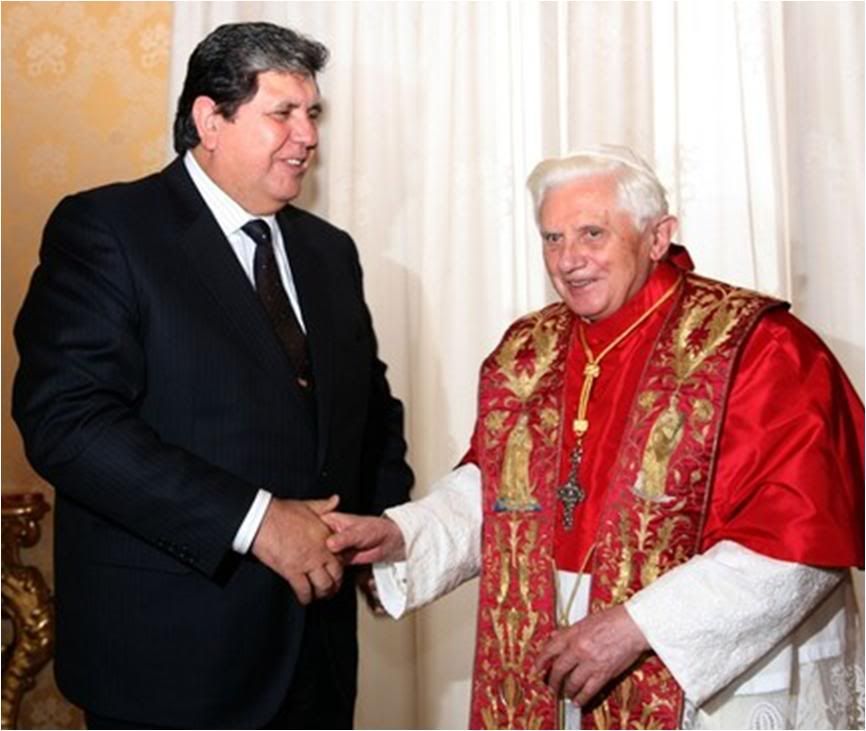
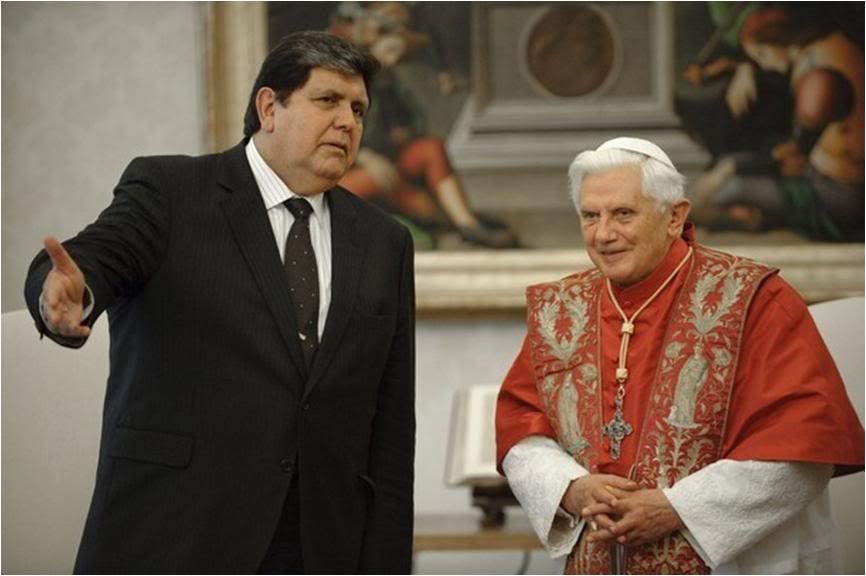
This morning, at the Apostolic Palace, the President of the Republic of Peru, H.E. Alan García Pérez, was received in audience by His Holiness Benedict XVI, and subsequently met with Cardinal Tarcisio Bertone, Secretary of State, and Mons. Dominique Mamberti, Secretary for Relations with States.
The cordial conversations allowed for a fruitful exchange of opinions on issues regarding the present international situation, especially in Latin America.
They dwelt on some aspects of the situation in Peru, especially the government's commitment to eradicate poverty, promote the rule of law, and safeguard the environment, as well as the collaboration between Church and State.
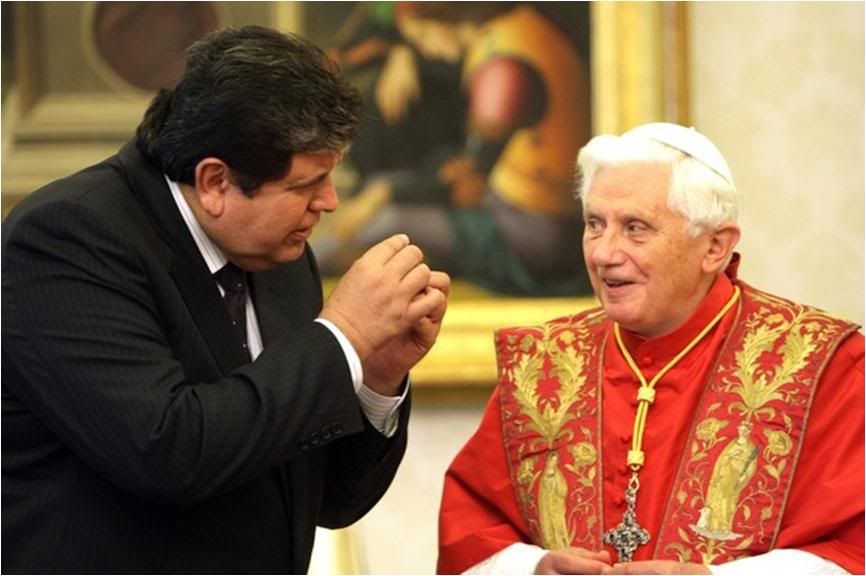
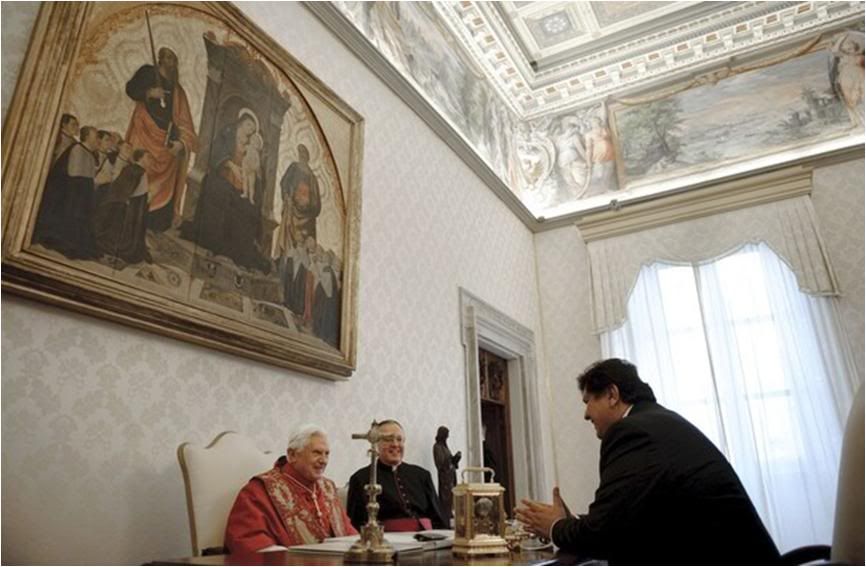

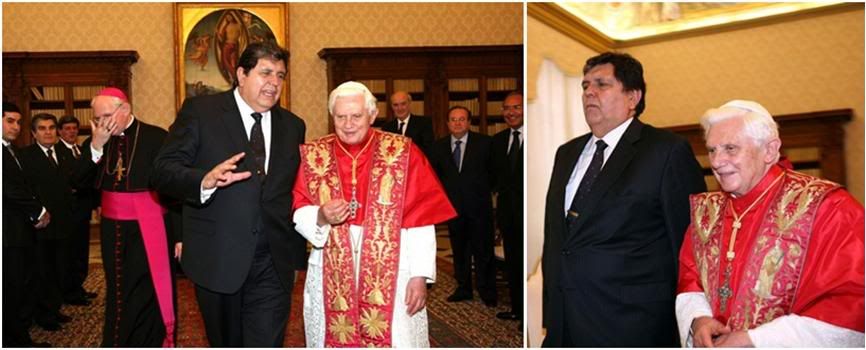
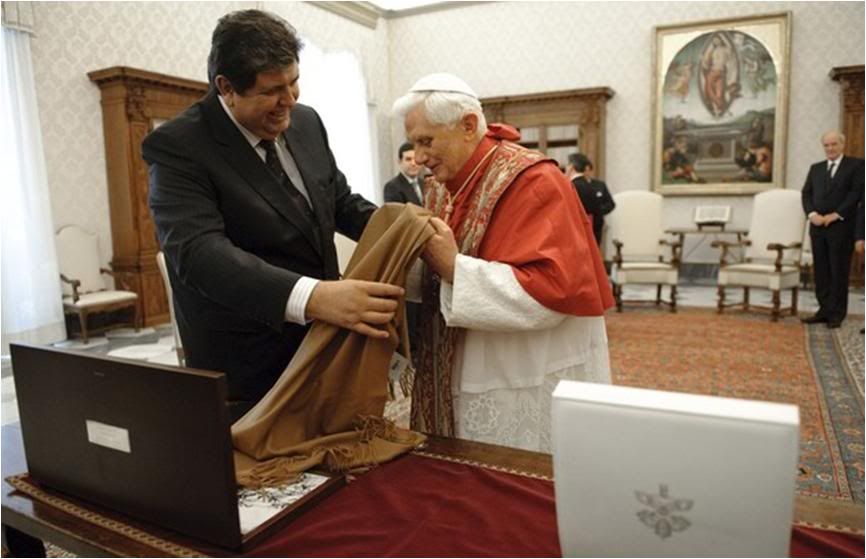
 NB: The newsphotos are so much sharper and brighter now, coming from the Daylife service, compared to the identical ones from Yahoo's newsphoto service (which I have relied on principally for over four years), Lately, the Yahoo photos, which are posted at 75% of original size, are fuzzy and ill-defined when blown up to 9-inches, which has become my preferred format. The Daylife photos, by contrast, enlarge beautifully and sharply.
NB: The newsphotos are so much sharper and brighter now, coming from the Daylife service, compared to the identical ones from Yahoo's newsphoto service (which I have relied on principally for over four years), Lately, the Yahoo photos, which are posted at 75% of original size, are fuzzy and ill-defined when blown up to 9-inches, which has become my preferred format. The Daylife photos, by contrast, enlarge beautifully and sharply.
For some time now, I have tried to post every usable photo I can find from Yahoo/Daylife on any event with the Holy Father - because I am sure no Benaddict can object to such an indulgence, and also because if I don't copy the newsphotos as soon as the services post them (and format them for the Forum), the services take them offline after a few days. Also, with the Pope's schedule, it's harder to catch up photowise if I miss picking up all the photos posted on one event.
[Modificato da TERESA BENEDETTA 30/11/2009 17:59] |
| |
 30/11/2009 18:20 30/11/2009 18:20 |
|
| | | OFFLINE | | Post: 18.974
Post: 1.621 | Registrato il: 28/08/2005
Registrato il: 20/01/2009 | Administratore | Utente Veteran | |
|
|
| |
 30/11/2009 22:37 30/11/2009 22:37 |
|
| | | OFFLINE | | Post: 18.975
Post: 1.622 | Registrato il: 28/08/2005
Registrato il: 20/01/2009 | Administratore | Utente Veteran | |
|

 This message on science and knowledge is very much a companion piece to the Holy Father's discourse on beauty and art at the Sistine Chapel - every bit as inspiring and inspired by faith.
Between science and faith -
This message on science and knowledge is very much a companion piece to the Holy Father's discourse on beauty and art at the Sistine Chapel - every bit as inspiring and inspired by faith.
Between science and faith -
no conflict at all
on the horizon,
says Benedict XVI
Translated from
the 12/1/09 issue of


Pope Benedict XVI has sent Archbishop Rino Fisichella, rector of the Pontifical Lateran University, a message for the international conference this week entitled "From Galileo's telescope to evolutionary cosmology: Science, philosophy and theology in dialog".
Here is a translation of the Pope's message:

To my Venerated Brother
Mons. Rino Fisichella
Rector Magnificus of
the Pontifical Lateran University
I am happy to address my greeting to all the participants of the International Congress on the theme "From Galileo's telescope to evolutionary cosmology: Science, philosophy and theology in dialog".
I particularly greet you, Venerated Brother, as the promoter of this important time of reflection in the context of the International Year for Astronomy.,celebrating the fourth centenary of the invention of the telescope.
My thoughts also go to Prof. Nicola Cabibbo, president of the Pontifical Academy of Sciences, who collaborated in preparing for the current sessions.
My cordial greetings to all the personalities who have come from different parts of the world who distinguish these days of study with their presence.
When one opens the Sidereus nuncius [The Starry Messenger, Galileo's first treatise describing his observations on the telescope] and reads the first statements of Galileo, what immediately shines forth is the Pisan scientist's wonder at what he himself had achieved:
"In these brief tract, I offer great things for the observation and contemplation of scholars of nature. Great, I say, because of the very excellence of the material in itself, the novelties that have never been seen before, and the instrument through which these things were made manifest to our senses" (Galileo Galilei, Sidereus nuncius, 1610, tr. P.A. Giustini, Lateran University Press 2009, p. 89).
It was 1609 when Galileo for the first time turned towards the heavens an instrument "thought out by myself", as he wrote, "enlightened first of all by divine grace": the telescope.
What presented itself to his eyes is easy to imagine: wonder turned to emotion and then to enthusiasm that made him write: "It is certainly a great thing to add, to the immense multitude of fixed stars that could be seen till now with natural visive faculties, more numberless stars never seen before and which surpass ten times over the number of ancient stars known till now" (ibid.).
The scientist could observe with his own eyes much that was up to then merely the result of controversial hypotheses.
One would not be mistaken to think that Galileo's spirit of a profound believer would open up naturally before that vision to a prayer of praise, taking for his own the words of the Psalmist:
'O LORD, our Lord, how awesome is your name through all the earth! You have set your majesty above the heavens!... When I see your heavens, the work of your fingers, the moon and stars that you set in place - What are humans that you are mindful of them, mere mortals that you care for them?... You have given them rule over the works of your hands, put all things at their feet" (Ps 8, 1,4-5,7).
With this discovery, awareness grew in the culture about being at a crucial point in the history of mankind. Science had become something different from what the ancients had thought.
Aristotle had arrived at the sure knowledge of phenomena starting from evident universal principles. Now Galileo had shown concretely how to come closer and observe the phenomena themselves in order to grasp their secret causes.
The deductive method yielded to the inductive and opened the way to experimentation. The concept of science that had lasted for centuries now changed, paving the way towards a modern concept of the world and of man.
Galileo had penetrated into the unknown ways of the universe. He opened the door for the observation of ever greater spaces. Probably beyond his intentions, the invention of the Pisan scientist also allowed stepping back in time, provoking new questions on the origin of the cosmos itself, and making it emerge that even the universe, which had come from the hands of the Creator, has its own story: it "moans and suffers the pains of birth' - to use the expression of the Apostle Paul - in the hope of being liberated 'from the slavery of corruption to enter into the freedom of the glory of the children of God" (Rm 8, 21-22).
Even today the universe continues to raise questions to which observation cannot give a satisfactory answer: the natural and physical sciences do not suffice. Indeed, the analysis pf phenomena, if it remains closed within itself, risks making the cosmos seen like an insoluble enigma: But matter possesses an intelligibility that can speak to human intelligence to show a way that goes far beyond the phenomena themselves.
It is the lesson of Galileo that leads to this consideration. Was it not the scientist from Pisa who said God had written the book of nature in the language of mathematics?
And yet, mathematics is an invention of the human spirit in order to understand Creation. If nature is really structured in a mathematical language and the mathematics invented by man can come to understand it, it means that something extraordinary has occurred: The objective structure of the universe and the intellectual structure of the human subject coincide - subjective reason and reason objectified in nature are identical.
Ultimately, there is 'one reason' that links them and which invites us to look to the one Creative Intelligence. (cfr. Benedetto XVI, Address to the Youth of the Diocese of Rome, in Insegnamenti II [2004], 421-422).
Questions on the immensity of the universe, on its origin and its end, as on understanding it, do not admit a single response of a scientific nature. Whoever looks at the cosmos, following the lesson of Galileo, cannot simply stop at what he observes through the telescope - he should proceed further to ask himself about the sense and the end towards which all creation is oriented.
Philosophy and theology, at this point, take on an important role, to smooth out the way towards farther knowledge.
Philosophy faced with natural phenomena and the beauty of creation seeks, through reason, to understand the nature and ultimate finality of the the cosmos.
Theology, based on the revealed Word, scrutinizes the beauty and wisdom of the love of God, who left his imprints on created nature (cfr. St Thomas Aquinas, Summa theologiae, ia. q. 45, a. 6).
In this gnoseologic movement [gnoseology = the science of knowledge], both reason and faith are involved: both offer their light. The more the knowledge of the complexity of the cosmos grows, the more it requires instruments that are satisfactory.
There is no conflict at all on the horizon among the various sciences and the knowledge of philosophy and theology. On the contrary, it is only to the degree that they are able to enter into dialog and interchange their respective competencies will they be able to present truly effective results to contemporary man.
Galileo's discovery was a decisive stage for the history of mankind. Other great conquests took off from it, with the invention of instruments that have made the technological progress we have achieved so precious.
From satellites that observe various phases of the universe, which has paradoxically become 'smaller', to the most sophisticated machines used in biomedical engineering, everything demonstrates the greatness of human intelligence which, according to the Biblical command, is called on to 'master' all of creation (cfr. Gen 1, 28), to 'cultivate' it and to 'safeguard' it (cfr. Gen 2, 15).
But there is always a subtle risk underlying such conquests: that man puts his trust in science alone and forgets to raise his eyes beyond himself to that transcendent Being, Creator of all, who revealed his face of Love in Jesus Christ.
I am certain that the inter-disciplinarity at this Congress will allow grasping the importance of a unitary vision, fruit of common labor for the true progress of science in the contemplation of the cosmos.
Venerated Brother, I gladly join your academic commitment, asking the Lord to bless these days as well as the research by each of you.
From the Vatican
26 November 2009


 The program of the conference (with speakers and their topics) may be found on
cms.pul.it/jx-link/575/3608
The program of the conference (with speakers and their topics) may be found on
cms.pul.it/jx-link/575/3608[Modificato da TERESA BENEDETTA 01/12/2009 01:16] |
| |
 01/12/2009 02:51 01/12/2009 02:51 |
|
| | | OFFLINE | | Post: 18.976
Post: 1.623 | Registrato il: 28/08/2005
Registrato il: 20/01/2009 | Administratore | Utente Veteran | |
|

 Moscow Patriarchate publishes
Moscow Patriarchate publishes
a book by Benedict XVI:
'Europe, spiritual homeland'
to be presented in Rome Dec. 2
Translated from
the Italian service of

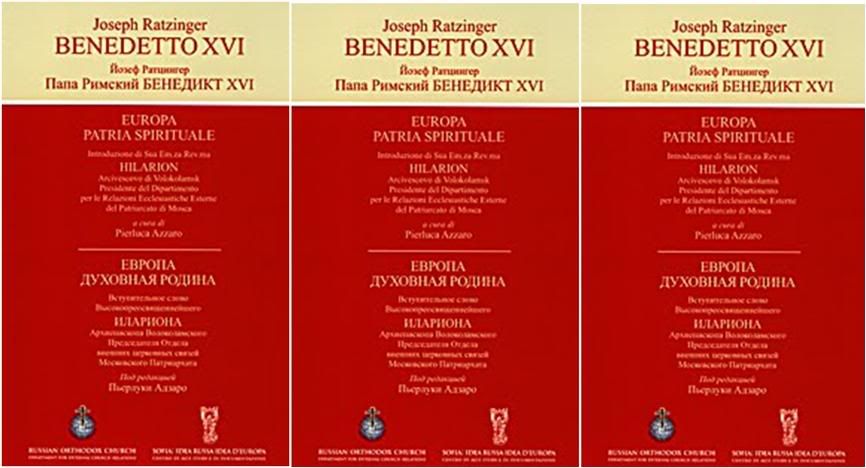
ROME, Nov. 30 (ZENIT.org) - The Patriarchate of Moscow has published a book entitled 'Europa, patria spirituale' in a bilingual Italian-Russian edition, which puts together the speeches of Joseph Ratzinger/Benedict XVI on the subject of Europe in the past decade.
The introduction to the book is by Archbishop Hilarion, head of the Department for External Ecclesiastical Relations of the Patriarchate, which initiated the project in cooperation with the Associazione Internazionale Sofia [Wisdom] and its program on Russian ideas, particularly the Russian idea of the Europe envisioned by the Treaty of Rome [which established the original European Common Market that was the mother association for the present European Union].
"This is a book of historic importance, without precedents in the millenary history of Catholics and Russian Orthodox," explained the book editor, Prof. Pierluca Azzaro, vicar president of the Sofia association and Professor of the History of Political Thought at the Catholic University of Milan.
"But first and foremost," the professor explained, "it is a great testimony of love for Christ and among Christians. It is from this love that European culture in all its multiform expressions should gush forth - a living culture, permeated by an authentically creative moral energy that is totally oriented towards the building of a good future for everyone".
"Europe - we are told by the Pope and by Archbishop Hilarion in his beautiful introduction - is a cultural continent with two wings, the Church of the East and the Church of the West, rising above the narrow duality of WesternEurope and Russia," Azzardo continues. "Thus Europe presents itself to us as our spiritual homeland, in the beautiful term that the Pope used during his last trip abroad to the Czech Republic".
Fr. Filipp, Hilarion's vicar and spokesman of the Foreign Relations department said: "This book brings together the addresses of the Holy Father on the fate of Europe and bears witness to the absolute identity of views and positions between the Catholic Church and the Russian Orthodox Church on modern social processes. It is also proof of the enormous possibilities in Catholic-Orthodox collaboration".
The book will be formally presented in Rome on Wednesday, December 2, at the Tapestry Hall of the Ministry for Economic Development on the Via Veneto during a roundtable discussion on "The role of the Church in the cultural integration of Europe".
It will be part of an ongoing Italian session of the Forum for Dialog of the Italo-Russian civic societies who meet in Rome and Moscow during bilateral summits between their leaders, this time, with Russian president Medvedev visiting Rome.
Participating in the discussions will be scholars and counselors from the Moscow Patriarchate and Moscow universities, and the Rector of the Catholic University of Milan, Fr. Lorenzo Ornaghi.
Both governments will be represented by Mikhail Shvydko, President Medvedev's counselor for international cultural cooperation, and by the Italian Minister for Cultural Assets Sandro Bondi.
Quite a high-powered, high-profile book presentation!
One really cannot underscore enough the unprecedented nature of this initiative by the Patriarchate of Moscow. For all their hemming and hawing about taking the next great step in advancing bilateral relations with Rome (i.e., their reluctance for a meeting between the Pope and the Patriarch of Moscow), they have been consistent and vocal in upholding the same Christian values that Joseph Ratzinger/Benedict XVI has been tirelessly preaching all these years.
It also marks the second time the Russians publish a Ratzinger book - they published Introduction to Christianity in Russian in 2006, for which Patriarch Kirill, then holding Hilarion's position now, wrote the introduction. [P.S. This is actually the third Ratzinger book published in Russian. The second was JESUS OF NAZARETH, vol. 1, in 2008.]
This is certainly an unprecedented situation in the history of world religions - for another Church to publish the books of the spiritual leader of the Catholic Church for their own faithful! I can't even imagine the Church of England doing that for the Pope.
And it's an obvious tribute to the literal catholicity of Joseph Ratzinger's faith, which is firmly Christian, unmistakably Catholic, and yet universally acceptable in its social implications to all who still hold to the great traditions of the world religions.
It's a signal recognition ,from a Church that has more than 200 million members, of the power of Joseph Ratzinger/Benedict XVI's voice and his tenacity in singlehandedly carrying on his 'crusade for Europe' [to borrow Dwight Eisenhower's term for the Allied mission in World War II], living up in every way to the Patron/Savior of Europe whose name he would take as Pope.
[Modificato da TERESA BENEDETTA 03/12/2009 14:57] |
| |
 01/12/2009 13:58 01/12/2009 13:58 |
|
| | | OFFLINE | | Post: 18.977
Post: 1.624 | Registrato il: 28/08/2005
Registrato il: 20/01/2009 | Administratore | Utente Veteran | |
|
 Tuesday, December 1
Tuesday, December 1
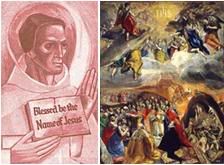 BLESSED GIOVANNI (John) DA VERCELLI (Italy, 1205-1283
BLESSED GIOVANNI (John) DA VERCELLI (Italy, 1205-1283
Dominican, Teacher, Preacher, Papal legate
A man of towering achievement who lived in an age of saints and worked with many of them
(E.G., Albertus Magnus, Thomas Aquinas, Bonaventure, St. Louis of France, Bernardine
of Siena), he came close to being elected Pope at one time in his long career, and served
two Popes but was not beatified until 1903. A secular priest, he taught at the University
of Paris and became a Dominican after his best students all joined the order. He went on
to be the sixth Dominican master-general, an office he held until his death. Meanwhile,
Gregory IX sent him to make peace among warring papal states and to settle a dispute
between France and Castile. He wrote the Schema for the second Council of Lyons in 1274,
which was called to fight the Albigensian heresy, among other things. He attended the Council
with Bonaventure (Aquinas died on his way to the Council), and founded the Holy Name
Society against blasphemy, perjury and immorality. The male sodality continues to be active
throughout the world today.
OR for 11/30-12/01/09:
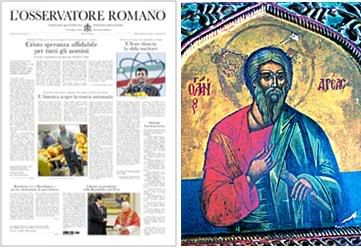 Illustration: Icon of St. Andrew.
Illustration: Icon of St. Andrew.
No photos from the Sunday Angelus, but the Holy Father's homily rates the headline on Page 1:
At the Angelus, the Pope says Christ's message is not only for believers:
'Christ is the trustworthy hope for all men'
 Other papal stories: the Pope's letter to Patriarch Bartholomew on the Feast of St. Andrew yesterday; his homily at Vespers to mark the start of Advent last Saturday (right photo, above); and his message to an international Congress on the dialog among science, theology and philosophy, 400 years after Galileo's invention of the telescope; and his audience with the President of Peru. In the inside pages, three stories in tribute to the French Jesuit Fr. Pierre Blet, the Vatican historian who compiled the 12-volume preliminary documentation of Pius XII's wartime activities - he died yesterday of a heart infarct at age 91. John Paul II used to say "Read Fr. Blet" whenever the subject of Pius XII and the Shoah came up. Page 1 international news: Iran defies the world by announcing ten new sites for enriching uranium; and 32 million Americans now use food stamps.
THE POPE'S DAY
Other papal stories: the Pope's letter to Patriarch Bartholomew on the Feast of St. Andrew yesterday; his homily at Vespers to mark the start of Advent last Saturday (right photo, above); and his message to an international Congress on the dialog among science, theology and philosophy, 400 years after Galileo's invention of the telescope; and his audience with the President of Peru. In the inside pages, three stories in tribute to the French Jesuit Fr. Pierre Blet, the Vatican historian who compiled the 12-volume preliminary documentation of Pius XII's wartime activities - he died yesterday of a heart infarct at age 91. John Paul II used to say "Read Fr. Blet" whenever the subject of Pius XII and the Shoah came up. Page 1 international news: Iran defies the world by announcing ten new sites for enriching uranium; and 32 million Americans now use food stamps.
THE POPE'S DAY
At 7:30 this morning, the Holy Father celebrated Mass at the Pauline Chapel with the members
of the International Theological Commission which is holding its annual plenary this week.
(As the Pope extemporizes his homily on occasions like this, the Vatican has not yet posted a text.)
THE POPE'S PRAYER INTENTIONS
FOR DECEMBER 2009
General Intention:
That children may be respected and loved and never be the victims of exploitation in its various forms.
Mission Intention:
That at Christmas the peoples of the earth may recognize in the Word Incarnate the light which illuminates
every man, and that the Nations may open their doors to Christ, the Saviour of the world
.
[Modificato da TERESA BENEDETTA 01/12/2009 19:42] |
| |
 01/12/2009 19:39 01/12/2009 19:39 |
|
| | | OFFLINE | | Post: 18.981
Post: 1.627 | Registrato il: 28/08/2005
Registrato il: 20/01/2009 | Administratore | Utente Veteran | |
|

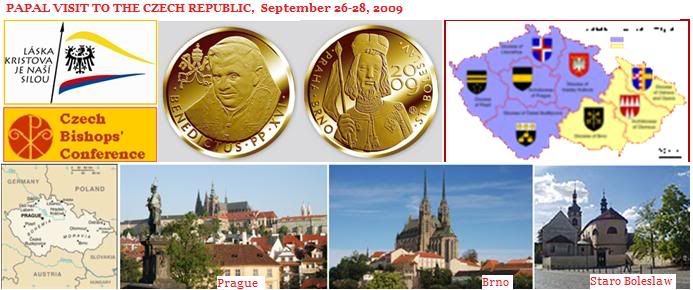 Echoes of the visit to Prague....
Prague's Infant Jesus statue
Echoes of the visit to Prague....
Prague's Infant Jesus statue
now wears Benedict XVI's crown

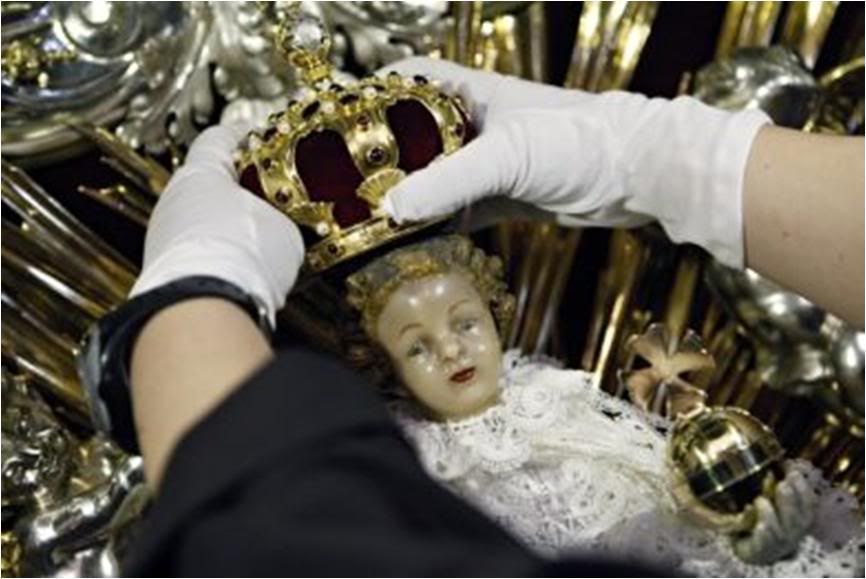 Note the scallops ('St Augustine's scallops') that are a motif in the crown.
Note the scallops ('St Augustine's scallops') that are a motif in the crown.
Prague, Nov 26 (CTK) - As of yesterday, the statuette of the Infant Jesus of Prague whom people from all over the world implore for aid is wearing the gilded crown Pope Benedict XVI offered during his September visit to the Czech Republic, according to Carmelite Prior Petr Sleich, whose order has custody of the shrine dedicated to the Holy Infant.
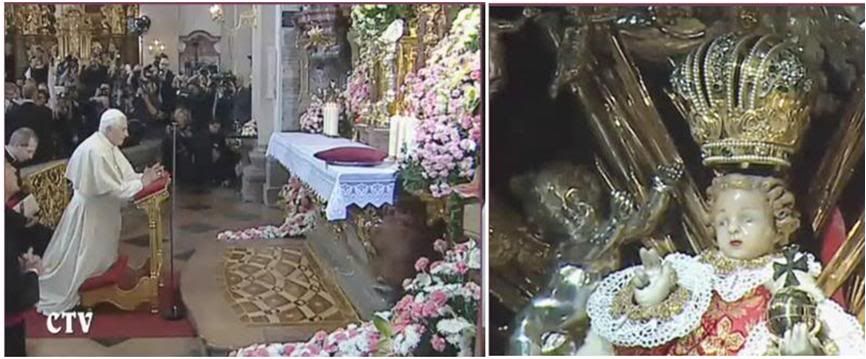
The crown was placed above the statuette when the Pope came to pray before it in the baroque Church of Our Lady Victorious, butit was then taken to a goldsmith who fitted it with catches and added a velvet underlay.
The statuette also wears an Advent dress as from yesterday.
The royal crown that Benedict XVI donated to Infant Jesus is decorated with eight shells, the symbol of St Augustine. An inscription with the date on which the Pope donated his gift is beneath the Cross on the crown, which is made of gold-plated silver and decorated with pearls and garnets.
The Infant Jesus statuette has about 100 garments, coming from various countries where devotion to him is widespread, such as China, Ecuador, Italy, the Philippines, Poland, the United States and Vietnam.
The Holy Infant of Prague is a 47-centimetre-high wax statuette with a wooden core, originally made by a monk in Spain.
In the late 16th century, it was brought to the Czech lands by a Spanish noblewoman, Maria Manrique de Lara, as her wedding present when she married a Bohemian nobleman.
The statuette passed further into the hands of their daughter, Polyxena. In 1628, she donated it to the Church of Our Lady Victorious, belonging to the order of the bare-footed Carmelites.
The Manrique de Lara family from the Canary Islands donated brocade clothes to the Infant Jesus in 1996.
Some clothes, including a velvet dress with a gold embroidery from Austro-Hungarian Empress Maria Theresa from 1743, are on display in the church museum.
Most of the clothes are kept in a baroque depository in the church. The statuette's robes are changed according to the liturgical season or church feast commemorated.
|
| |
 02/12/2009 01:30 02/12/2009 01:30 |
|
| | | OFFLINE | | Post: 18.983
Post: 1.630 | Registrato il: 28/08/2005
Registrato il: 20/01/2009 | Administratore | Utente Veteran | |
|

 Two things that neither OR nor Vatican Radio mention about the Mass is that it is the first Mass celebrated by the Pope in the renovated Pauline Chapel since it was inaugurated with Vespers on July 4, and that the Holy Father celebrated the Mass 'ad orientem', although the altar of the chapel was specially moved forward to allow for celebrating the Mass 'ad orientem' or 'ad popolo'.
Pope concelebrates Mass
Two things that neither OR nor Vatican Radio mention about the Mass is that it is the first Mass celebrated by the Pope in the renovated Pauline Chapel since it was inaugurated with Vespers on July 4, and that the Holy Father celebrated the Mass 'ad orientem', although the altar of the chapel was specially moved forward to allow for celebrating the Mass 'ad orientem' or 'ad popolo'.
Pope concelebrates Mass
with theologians
in the Pauline Chapel
Translated from
the 12/2/09 issue of

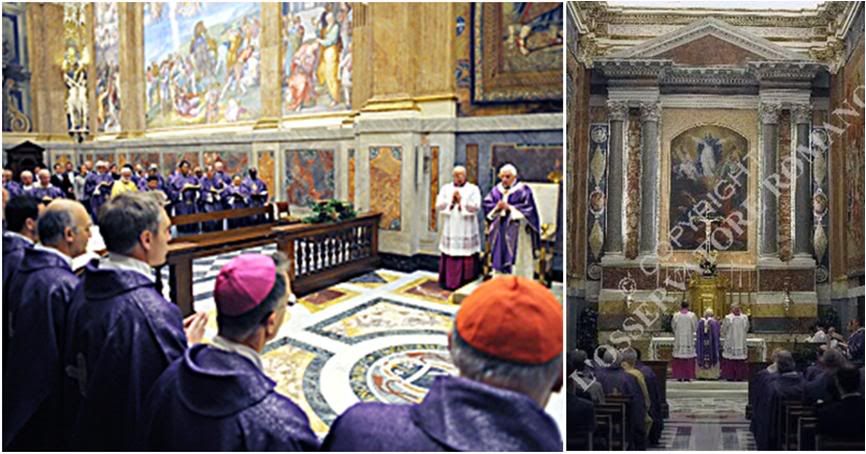 Left photo is the picture appearing in tomorrow's OR; all the rest of the photos were taken by NLM from the OR photo files, hence the watermarks.
Left photo is the picture appearing in tomorrow's OR; all the rest of the photos were taken by NLM from the OR photo files, hence the watermarks.
On Tuesday morning, the Pope presided at a Mass in the Pauline Chapel concelebrated with the members of the International Theological Commission who are holding their annual plenary assembly Nov. 30-Dec. 4 at the Domus Sanctae Marthae in the Vatican.
During this session, which marks the 40th anniversary of the creation of the Commission by Pope Paul VI, the theologians will choose the issues that they propose to take up in the next five years.
Cardinal William Joseph Levada, Prefect of the Congregation for the Doctrine of the Faith and ex officio President of the Commission, has asked them to continue deliberating on theological methodology, which was a subject they started to consider in the five-year period that just ended.
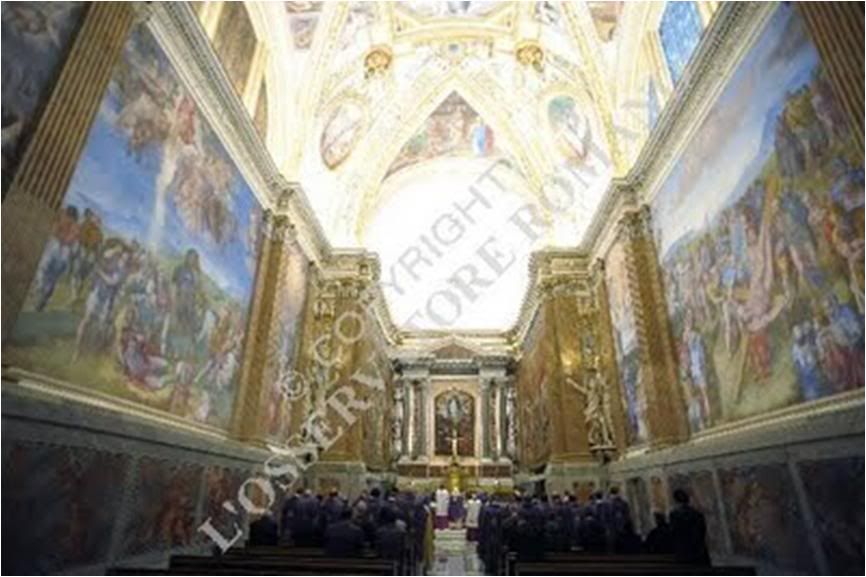 Disappointingly, the OR does not carry the text of the Pope's homily, nor has the Press Office posted it online yet. For now, here's the Vatican Radio report on it:
Disappointingly, the OR does not carry the text of the Pope's homily, nor has the Press Office posted it online yet. For now, here's the Vatican Radio report on it:
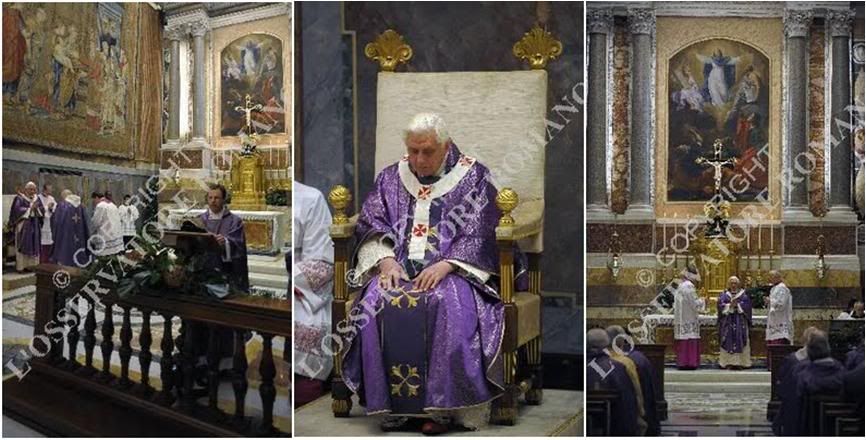 The Pope to theologians:
The Pope to theologians:
Without the humility to feel small,
it is not possible to understand God
Translated from
the Italian service of

Dec. 1, 2009
The true theologian is he who does not yield to the temptation to measure the mystery of God with his own intelligence, in the process, often emptying all sense from the figure of Christ.
The true theologian is conscious of his limitations, like so many saints who are also recognized as great teachers and thinkers.
These statements synthesize the homily that Benedict XVI addressed this morning to the members of the International Theological Commssion at a Mass in the Pauline Chapel. Alessandro De Carolis reports:
Benedict XVI sees the prototype of the all-knowing theologian who studies Sacred Scripture as some scientists study nature - namely, with academic coldness which would vivisect the mystery of God and ignore the spark of the transcendent - in the ancient scribes who told the Magi to follow the road to a newborn King in Bethlehem.
He said they were "great specialists: they could say where the Messiah would be born" but "did not feel called on to go see him themselves".
The news "did not tocuh their life - they remained out of it. They could give information, but such information did not become formation for their own lives".
"Thus, even in our time, in the last 200 years, we have observed the same thing. There are great thinkers, great specialists, great theologians, masters of the faith who have taught so many things. Thye have penetrated into the details of Sacred Scripture, into the history of salvation. But they have been unable to see the mystery itself, the real nucleus: that Jesus is really the Son of God...
"It is very easy to name great personalities in the history of theology in the past 200 years from whom we have learned a lot, but who failed to uncover mystery with the eyes of the heart".
The Pope was severe about this method of theology by which, he said, "the theologian places himself above God". He is equally severe with scientists whose attitude is that "God has nothing to do with this (science)" and therefore, "there is no God".
But he is most severe with a theology that minimizes the divine, describing their deficiency with an effective image:
Such theologians "fish in the waters of Sacred Scripture with a net whose mesh only allows certain fish to be caught, and any fish that do not fit the mesh are left out, and therefore do not exist. Thus, the great mystery of Jesus, the Son of God who made himself a man, is reduced to a historical Jesus, who is really a tragic figure, but a phantasm without flesh and bone, or one who has remained in the sepulcher, corrupted, truly dead."
But, the Pope pointed out, the history of the Church is rich with men and women who could acknowledge their own smallness in the face of the grandeur of God, persons capable of humility, and therefore, of reaching the truth.
The Pope cites some names: "From Bernadette Soubirous to Therese of Lisieux, with a new reading of Sacred Scripture that was not scientific but went to the heart of Scripture, up to the saints and blesseds of our time: Sister Bakhita, Mother Teresa, Damian de Veuster. The list is long."
He called them a category of "little people who are also wise", models that inspire. He expressed the hope that "they may help us to be true theologians who can announce the mystery of Christ because it has touched us in the depths of our heart". Like Our Lady, or St. John, or the centurion at the Cross. Or St. Paul whose experience epitomizes in an emblematic way the trajectory of passage from false wisdom to true wisdom:
"And thus, after his resurrection, the Lord, along the road to Damascus, touched the heart of Paul, who had been one of those educated men who did not see. He himself, in his first letter to Timothy, says he was ignorant then, notwithstanding his great knowledge.
"But the Risen Lord touched him. He becomes blind and thus becomes truly a sser. He starts to see. The great rabbi becomes someone small, and it is as such that he sees the foolishness of God which is wisdom greater than all of human wisdom".
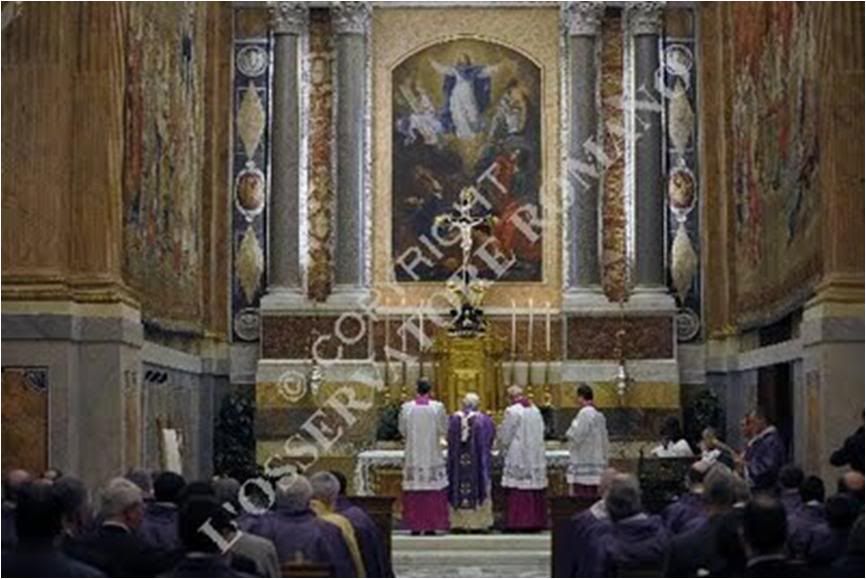
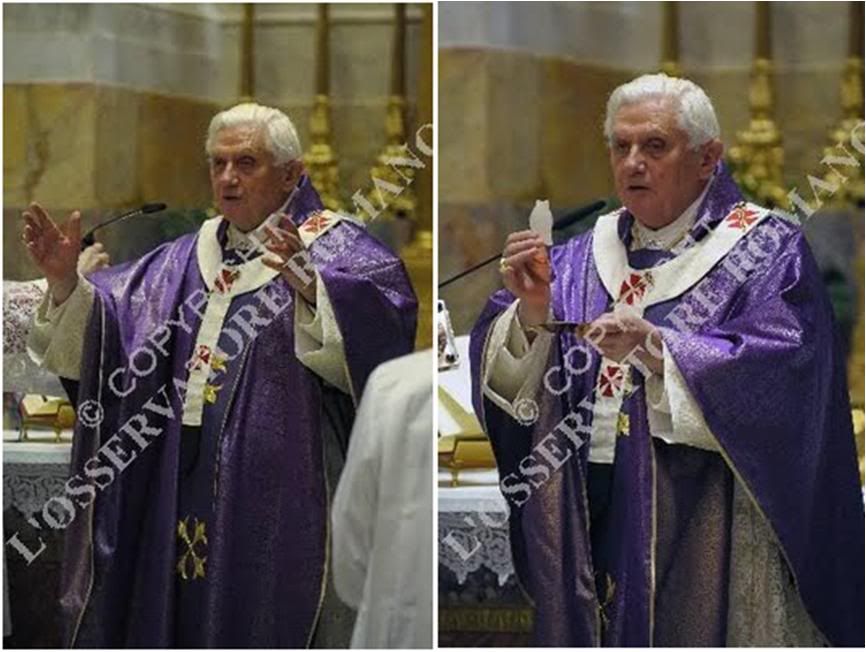
12/2/09
The Vatican Press Office released the the text of the homily this morning. Here is a translation:
Dear brothers and sisters,
The words of the Lord, which we heard just now in the Gospel passage, are a challenge to us theologians, or perhaps, better said, an invitation to an examination of conscience: What is theology? What are we as theologians? How does one do theology well?
We heard how the Lord praises the Father because he has hidden the great mystery of the Son, the Trinitarian mystery, the Christologic mystery, from the wise men and the learned - they have not known these mysteries - but has revealed it to the little people, to those who are not learned, who have no great culture. To them he revealed this great mystery.
With these words, teh Lord describes simply a fact of his life: a fact which begins at the time of his birth, when the Magi from the East asked the experts, the scribes, the exegetes, for the place of birth of the Savior, the King of Israel.
The scribes knew it because they were great specialists. They could say right away where the Messiah would be born - in Bethlehem. But they did not feel called on to go there themselves: for them, it was just academic knowledge which did not touch their lives; they remained out of it. They could give information, but such information did not become formation for their own lives.
Then, during the public life of the Lord, we find the same thing. It was inaccessible for the learned ones to understand that this unschooled man, this Galilean, could really be the Son of God. It was unacceptable to them that God, the great, the one and only, God of heaven and earth, could be present in this man.
They knew everything, even Isaiah 53, and all the great prophecies, but the mystery remained hidden to them.
Instead, it was revealed to the little people, from Our Lady to the fishermen on the Lake of Galilee. They knew, as did the Roman centurion at the foot of the Cross knew: this is the Son of God.
The essential facts of the life of Jesus do not belong only to the past, but they are present, in different ways, in all generations. So, even in our time, in the last 200 years, we have observed the same thing.
There are great scholars, great specialists, great theologians, teachers of the faith who have taught us many things. They have penetrated into the details of Sacred Scripture, into the history of salvation, but they have not been able to see the mystery itself, the true nucleus: that Jesus is truly the Son of God, that the trintiarian God had entered our history, at a certain historical moment, in a man like us.
The essential has remained hidden (to them). One can easily cite great names in the history of theology of the past 200 years, from whom we learned much, but the mystery remained closed to the eyes of their heart.
On the other hand, even in our time, there are the little ones who knew this mystery. We can think of St. Bernadette Soubirous, of St. Therese of Lisieux, with her new 'non-scientific' reading of the Bible which enters into the heart of Sacred Scripture; up to the saints and blesseds of our day: St. Giuseppina Bakhita, Blessed Teresa of Calcutta, St. Damian de Veuster. We can name so many!
But from all this, the question arises: Why is it so? Is Christianity the religion of simple people, of those without culture, of the uneducated? Is faith extinguished when reason comes awake? How do we explain this?
Perhaps we must look at history again. What Jesus said remains true - all that could be observed through the centuries. Nonetheless there is a 'species' of little people who are also learned. At the foot of teh Cross, there was Our Lady, the humble handmaid of the Lord and the great woman enlightened by God. There was John, fisherman of Galilee, who would rightly be called 'the theologian' by the Church, because he truly saw the mystery of God and announced it - with the eyes of an eagle, he penetrated into the inaccessible light of divine mystery.
And thus, after his recurrection, the Lord, along the road to Damascus, touched the heart of Saul, who had been one of those learned men who could not see. He himself in the first letter to Timothy, says he was 'igornant' at the time, notwithstanding all his knowledge.
But the Risen Lord touched him: he becomes blind, but at the same time, becomes truly a seer. He begins to see. The great rabbi becomes a small person, and because of this, he sees that the 'pointlessness' of God is wisdom, a knowledge greater than all of human knowledge.
We can continue to read all history in this way. Just one more observation. These learned sages, sofoi e sinetoi, in the First Reading today, appear in another way. Here, sofia and sinesis are gifts of the Holy Spirit that dwell in the Messiah, on Christ.
What does it mean? What emerges is that theire is a dual use for reason and a dual way of being wise or small.
There is a way of using reason that is autonomous, that places itself above God, in the whole range of the sciences, starting with the natural sciences, in which a method adapted for research into matter becomes universalized. In this method, God has no part, therefore, God does not exist.
And that has happened too in theology. There are those who fish in the waters of Sacred Scripture with a net whose mesh only allows certain fish to be caught, and any fish that do not fit the mesh are left out, and therefore do not exist. Thus, the great mystery of Jesus, the Son of God who made himself man, is reduced to a historical Jesus, who is really a tragic figure, a phantasm without flesh and bone, or one who has remained in the sepulcher, corrupted, truly dead.
This method can 'capture' certain fish, but excludes the great mystery, because man has made himself the measure: he has this arrogance, but at the same time, great stupidity, because he absolutizes certain methods that are not appropriate for the great realities. He enters into this academic spirit that we saw in the ancient scribes who answered the questions of the Magi: "It has nothing to do with me. I remain enclosed in my existence which is not touched at all."
This is specialization that sees all the details but can no longer see the totality.
There is another way of using reason, of being wise - that of the man who knows who he is: he knows his own measure and the greatness of God. He opens himself humbly to the novelty of God's action.
Thus, while accepting his own smallness, making himself small as he really is, he arrives at the truth. In this way, reason can express all its possibilities, it does not exhaust itself but broadens itself - it becomes larger.
This is another kind of sofia and sinesis, which does not exclude man from mystery, but is truly communion with the Lord in whom wisdom and knowledge dwell, along with their truth.
At this time, let us pray so that the Lord may give us true humility. May he give us the grace to be small so that we may be truly wise. May he enlighten us and make us see his mystery in the joy of the Holy Spirit.
May he help us to be true theologians who can announce his mystery because we have been touched by it in the depths of our own heart, in our own existence. Amen!
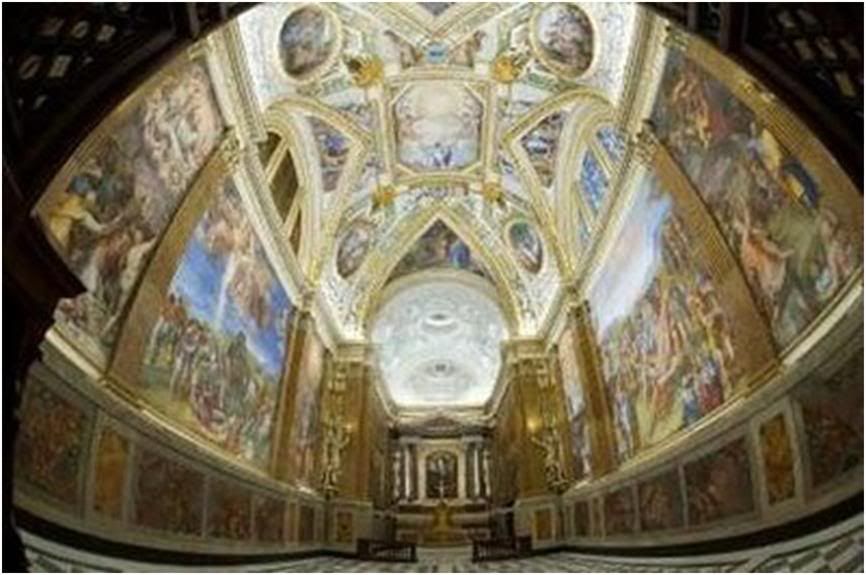
[Modificato da TERESA BENEDETTA 02/12/2009 17:16] |
| |
 02/12/2009 12:42 02/12/2009 12:42 |
|
| | | OFFLINE | | Post: 18.984
Post: 1.631 | Registrato il: 28/08/2005
Registrato il: 20/01/2009 | Administratore | Utente Veteran | |
|

 What kind of book introduction
What kind of book introduction
mentions nothing of the book
nor the author at all?
As posted yesterday, the Patriarchate of Moscow has published a book entitled 'Europa, patria spirituale' in a bilingual Italian-Russian edition, which puts together four speeches of Joseph Ratzinger/Benedict XVI on the subject of Europe in the past decade.
The introduction to the book is by Archbishop Hilarion, head of the Department for External Ecclesiastical Relations of the Patriarchate, which initiated the project in cooperation with the Associazione Internazionale Sofia [Wisdom].

I have definitely curbed all my enthusiasm about this book project [the project, not the book], now that I have read Archbishop Hilarion's lengthy 'Introduction', published in full by L'Osservatore Romano, in today's issue (12/2/09).
Hilarion does not make one single reference at all to the contents of the book nor even to Cardinal Ratzinger or Benedict XVI. I don't think I'm just being touchy to say this is an unheard of discourtesy - and it is so glaring it must be deliberate! But why? And by a high-ranking, well-educated, highly cultured prelate?
The introduction is certainly interesting and informative about the Russian Orthodox Church and its vision for Europe, not to mention an opportunity to point with pride to a document "The Foundations of the Social Doctrine of the Russian Orthodox Church", a discussion that takes up half of the Introduction.
But there was not even an attempt to link any of the positions articulated in the Introduction to those of the Pope. I cannot but conclude that in publishing this book, the Russians meant to ride piggyback on Cardinal Ratzinger/Benedict XVI's prestige to publicize their point of view about Europe in a way they would not get on their own.
Of course, anyone who buys the book will certainly not limit himself to just reading the Introduction and get to the Pope's speeches. Still, I find the circumstances of this 'Introduction' don't make sense at all! What would it have cost Hilarion to add a single line that ties in all that Hilarion says to what Benedict XVI has been advocating to Europe and and for Europe?
Here is the Editor's Note that preceding Hilarion's Introduction in OR:
]"The role of the Church in the cultural integration of Europe" is the subject of the roundtable Tuesday evening in Rome at the Ministry for Economic Development, at the presentation of the book 'Europa patria culturale' by Joseph Ratzinger/Benedict XVI.
The event takes place within this year's Italian session of the Forum for Dialog of the Italo-Russian civic societies.
The book is a collection of three discourses by Cardinal Joseph Ratzinger and one by Benedict XVI on the subject of Europe, published in a bilingual Italian-Russian edition by the Russian Orthodox Patriarchate of Moscow(231 pp).
Since the Introduction says not a word about Benedict XVI, I will be posting the translation (I'm only two-thirds through, and I'd rather translate the Pope's catechesis now) in the CHURCH&VATICAN thread.
[Modificato da TERESA BENEDETTA 02/12/2009 13:03] |
| |
 02/12/2009 13:27 02/12/2009 13:27 |
|
| | | OFFLINE | | Post: 18.985
Post: 1.631 | Registrato il: 28/08/2005
Registrato il: 20/01/2009 | Administratore | Utente Veteran | |
|
 Wednesday, Dec. 2
Wednesday, Dec. 2
 BLESSED RAFAL CHYLINSKI (Poland, 1694-1741)
BLESSED RAFAL CHYLINSKI (Poland, 1694-1741)
Franciscan
Jesuit-educated, Rafal became a cavalry officer before joining
the conventual Franciscans in 1715. After being assigned to
nine different cities, he ended up in Lageniewski where he
served to the end of his life. He was known for his simple
and candid sermons and for his holy ministry. After his death,
the church he served immediately became a place for pilgrimage.
He was beatified in 1991.
OR today.
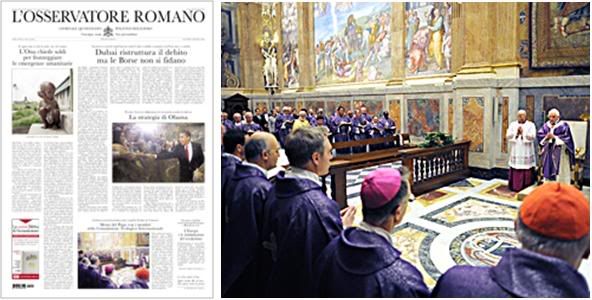 The only papal news in this issue is the Holy Father's Mass with the International Theological Commission
The only papal news in this issue is the Holy Father's Mass with the International Theological Commission
(but without the text of the homily). Other Page 1 news: The United Arab Emirates assure their economic
solidity is not at risk as Dubai restructures its $59-billion debt; the UN calls for more funds for
humanitarian emergency assistance; and Obama unveils 'new' Afghan strategy which includes sending
30,000 more US troops to Afghanistan. The inside pages contains the Introduction by Russian orthodox
Archbishop Hilarion Alfeyev to a Russian-published book containing four of Cardinal Ratzinger/
Benedict XVI's discourses about Europe in the past decade, but the essay does not mention the book
or the Pope's name at all.
THE POPE'S DAY
General Audience today - The Holy Father's catechesis was on Guillaume (William) de St. Thierry,
a 12th century Belgian monk and writer he described as 'the singer of love' as the primary virtue.
|
| |
|
|
|
|